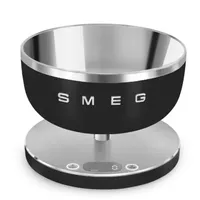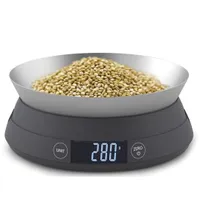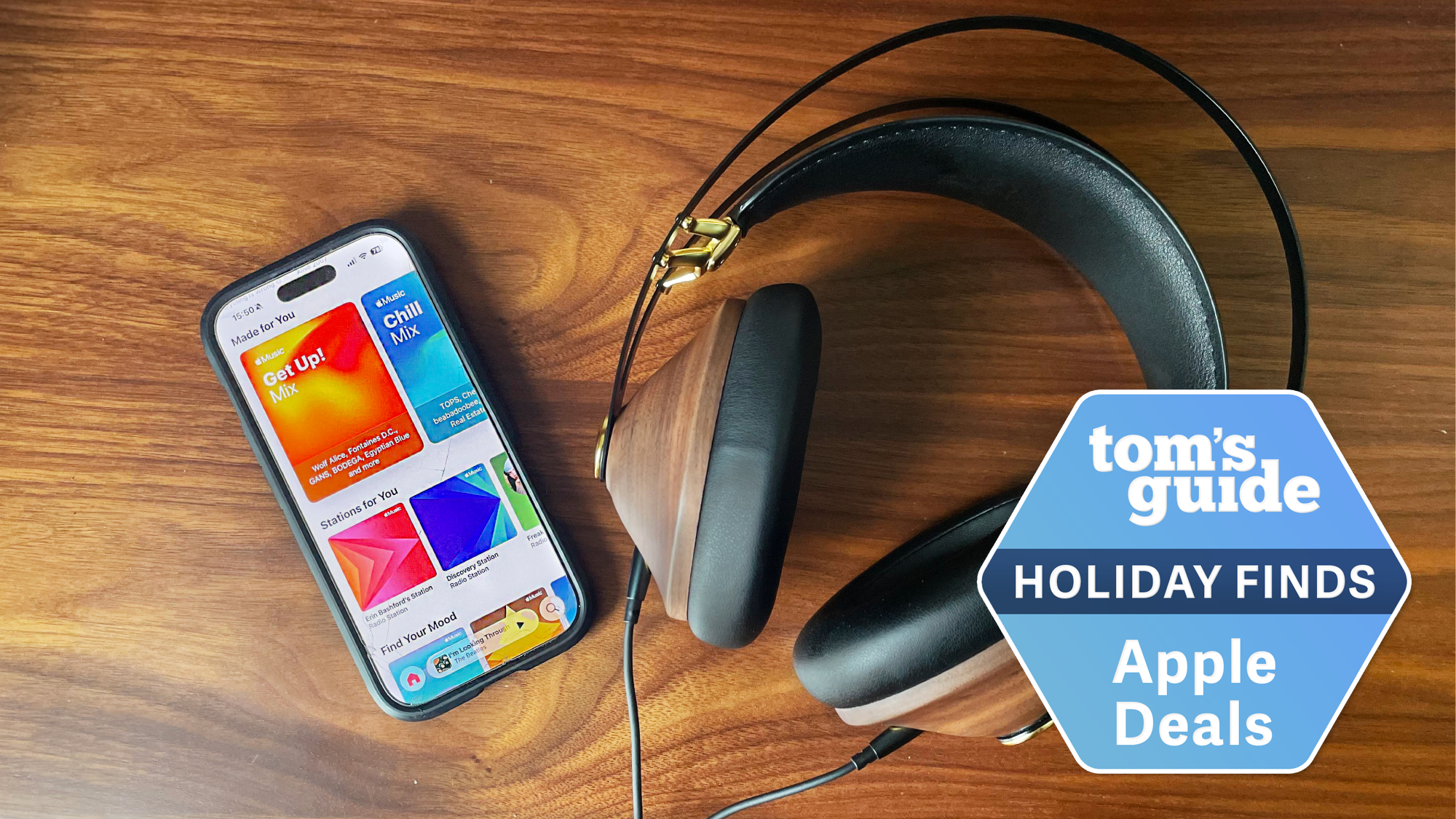I spent hundreds of hours cooking to test the best kitchen scales — these are the 7 scales I recommend
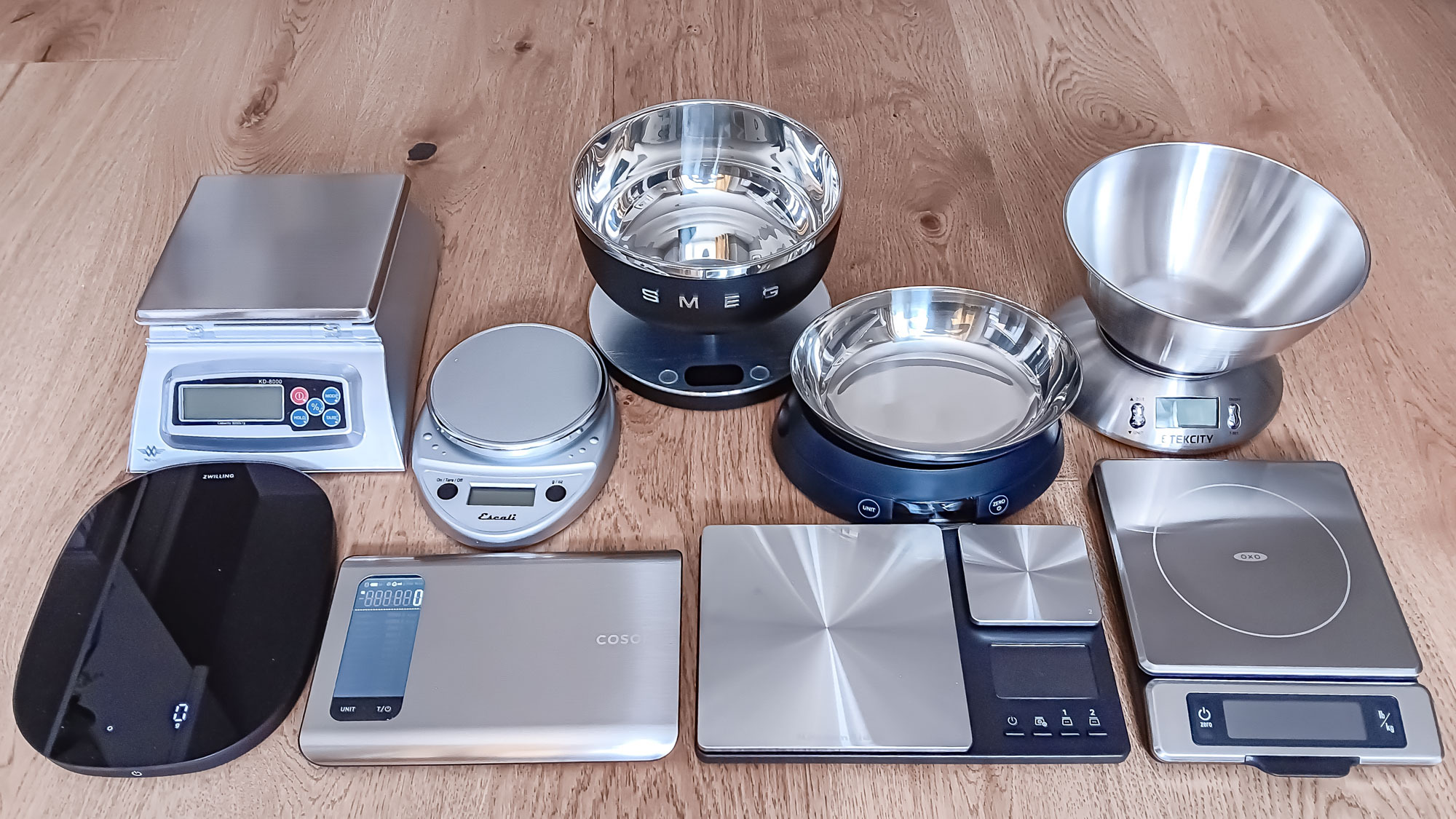
I’ve been baking ever since I could see over my mom’s kitchen countertop, and I’ve continued to whip up plenty of tasty treats and hearty meals for my own now grown-up family. So, with more than enough experience behind me, I know what makes a good pair of kitchen scales.
I selected a comprehensive mix of kitchen scales, from those with bowls to those with pull-out digital displays and even some with smart features. I then put them to the test.
Each kitchen scale reviewed for this guide has undergone the same testing criteria, starting with measuring calibrated weights to verify accuracy. I’ve also used each scale for everyday cooking to test its performance in terms of ease of use, evaluating the controls, display, and practical aspects of using the bowl (if included), as well as how easy it is to clean and store. Here are the results.
My favorite kitchen scales
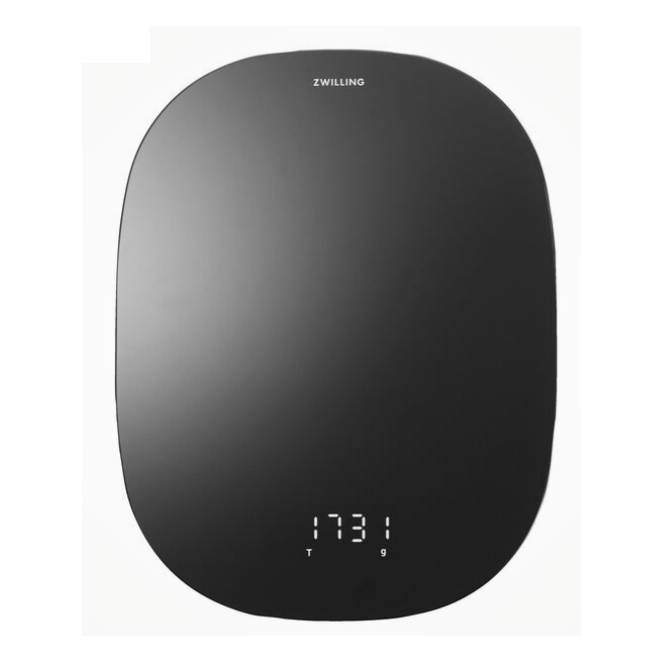
This kitchen scale is slim, sleek and compact, with the simplicity of one touch control positioned on the front edge of the scale and the display integrated into the measuring platform. Don't be fooled by its minimalism, because it's a great performer.
Read more below

The Escali Primo Digital Kitchen Scale doesn’t win on looks, unless you opt for one of the color-popping versions, but it’s a great performer and accurate when weighing precise weights. The weighing platform is a little small, but it’s a smart budget buy.
Read more below
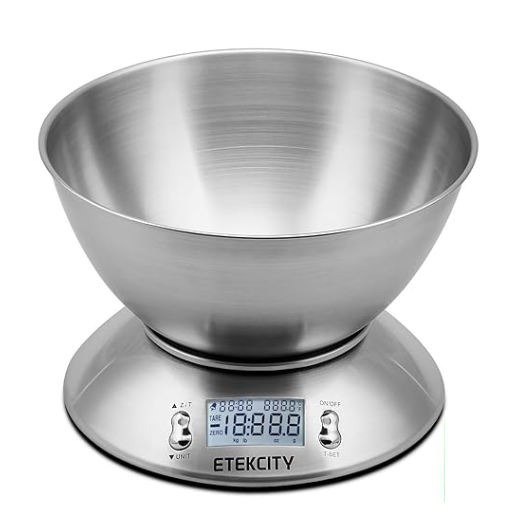
This kitchen scales offers a lot of bang for its buck and provides a generous bowl to measure ingredients. It's also exceptionally accurate and quick. The only drawback is its looks, but functionality pips appearance with this one.
Meet our tester

I’m a staff writer on the Homes team at Tom’s Guide, and I take care of selecting, testing, and writing about the kitchen scales we review and recommend. My expertise comes from years of experience in the kitchen and knowing how accuracy, ease of use, cleaning, and functionality are all key aspects when making a purchasing decision.
My testing criteria

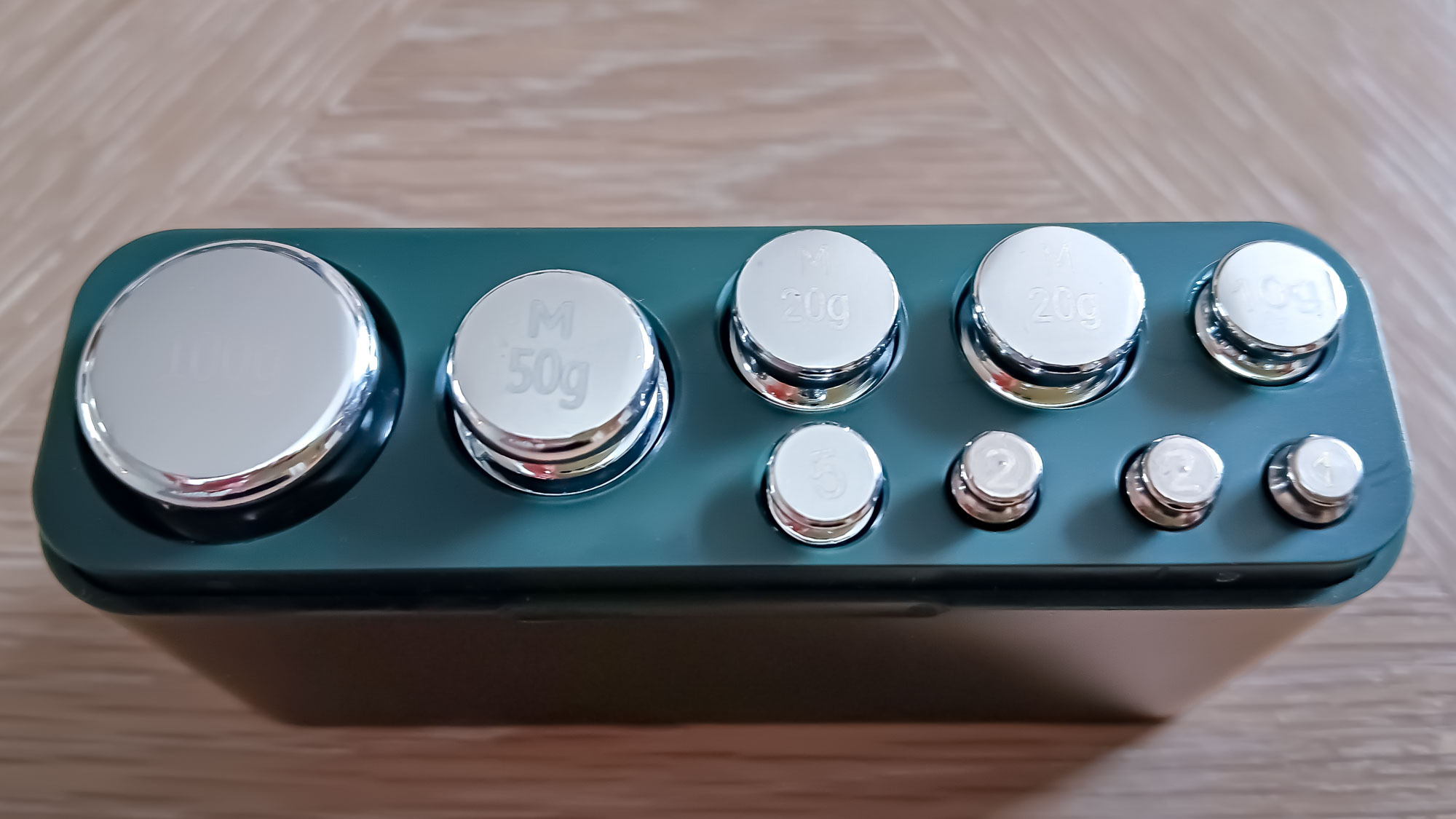
I researched online to find a mix of kitchen scales to test, finding those with and without bowls and added functions, such as precision weighing. From this, I selected 9 kitchen scales to put through their paces.
Weighing them up
The main test was to check the scales for accuracy, and I used a set of calibration weights based on grams, including 1g, 2g, 10g, 20g, 50g and 100g. I started by using a 1g weight and increased the amounts. I also moved the weights around the scales to see if the measurement remained the same whether they were placed in the center or outer part of the scales. I finished by adding 171g in weight.
Speed
While testing the weights I also noted how quickly the scales responded to the change when the weights were added and removed. I also checked how long the display stayed fixed before it went into auto-off, and whether this aligned with what was mentioned in the manual.
Design and practicality
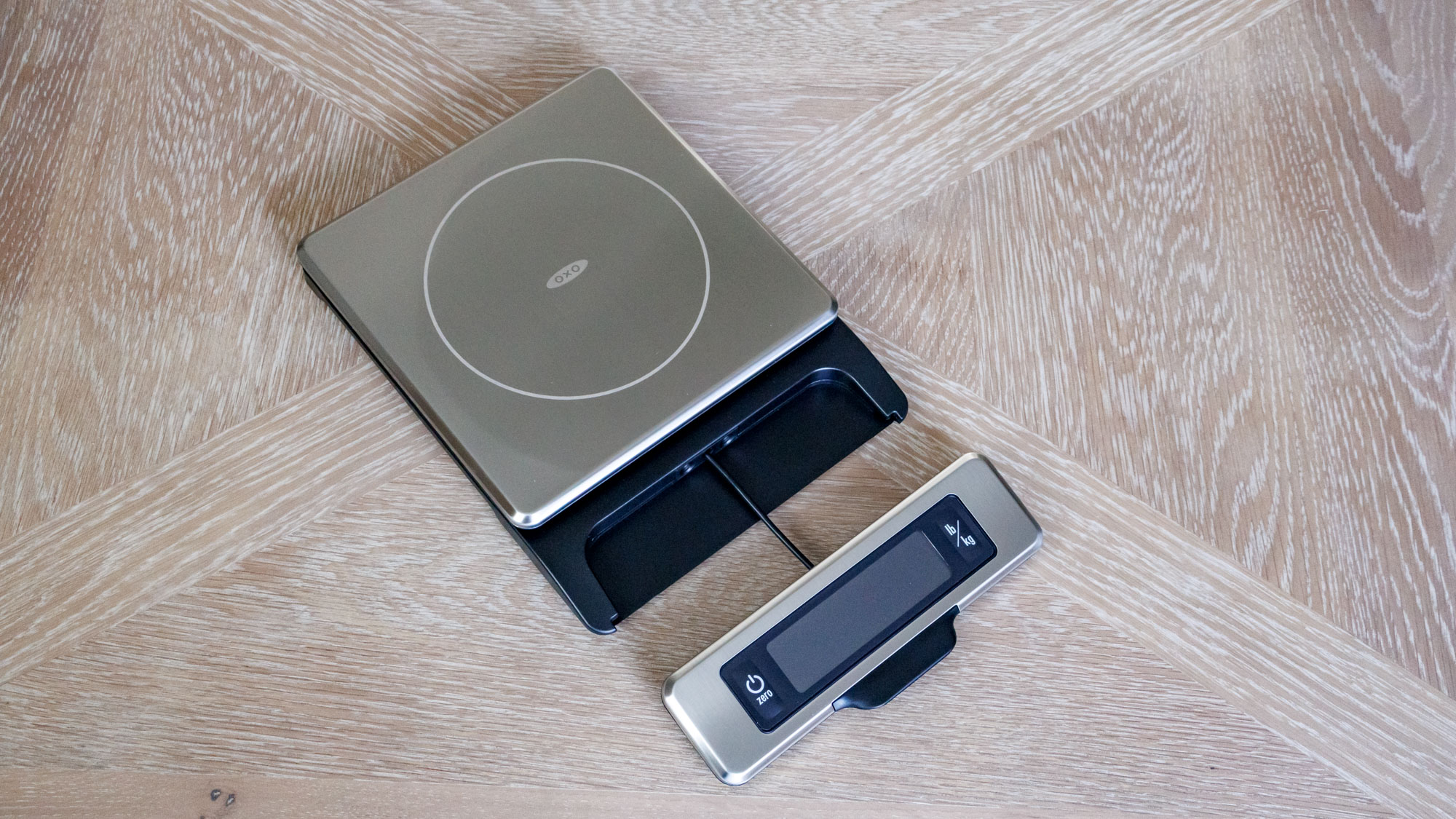
Additionally, I considered the overall design and how easy the kitchen scales would be to store to ensure they wouldn’t become damaged in a cupboard. Another element included how the bowl fitted (if relevant), and whether it was secure once on the base.
Ease of use
You don’t want to buy a kitchen scale that is difficult to navigate, as you want to get on with the job in hand, so I worked my way around using the controls, and checking the ease of replacing the battery or using the charging cable.
Functionality
Most of us probably won’t need many bells and whistles when buying kitchen scales. Still, for those who want added functionality, I observed what additional features were on offer, such as smart features or a smaller scale for precision measurements.
Cleaning
Even when I start with good intentions, I get messy in the kitchen, and my kitchen scales do too. Therefore, it was essential to see how easy the scales were to clean – checking if any cleaning products should be avoided and whether they took more effort than others.
The best kitchen scales you can buy right now
Why you can trust Tom's Guide
Best kitchen scale overall


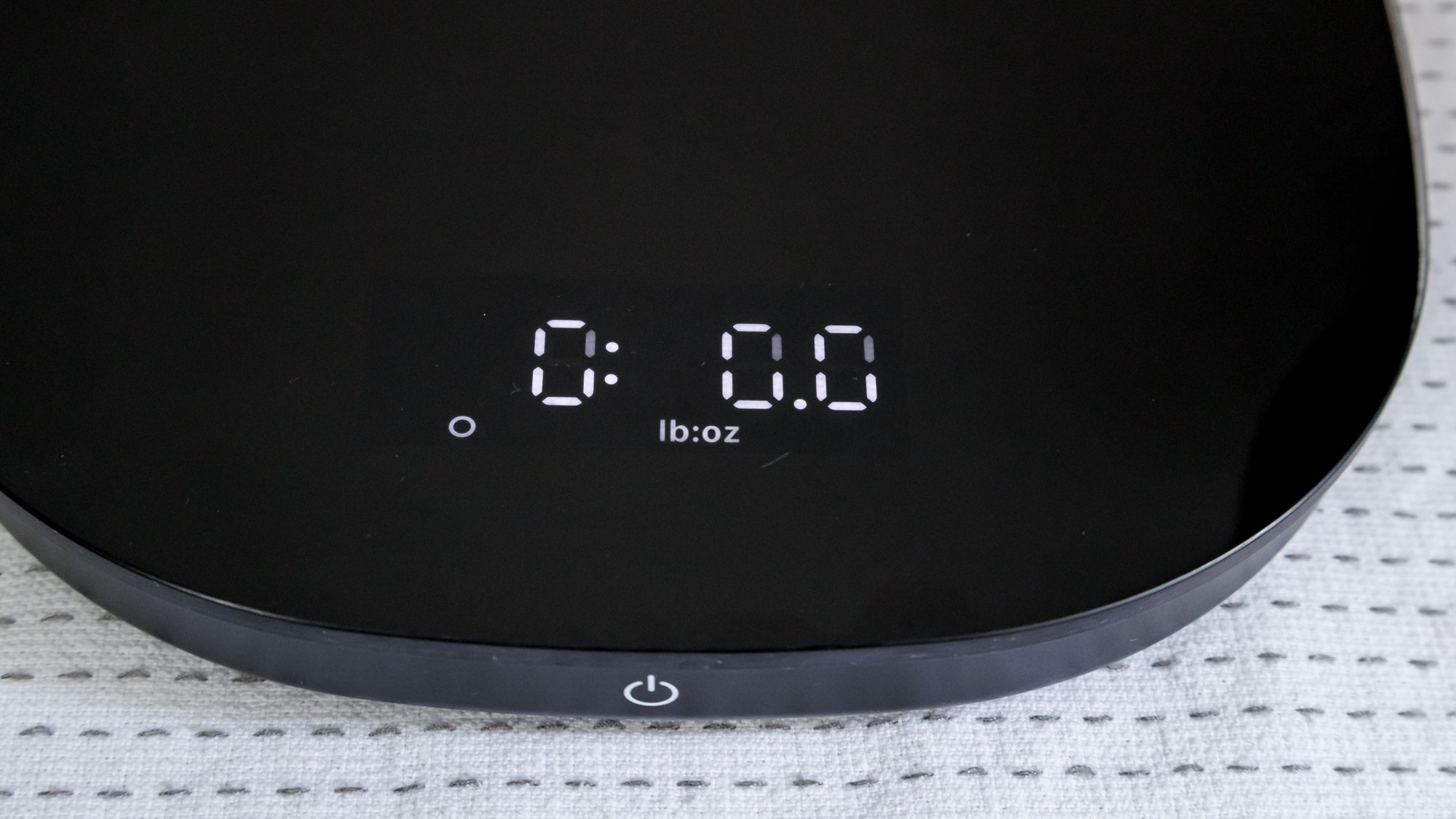
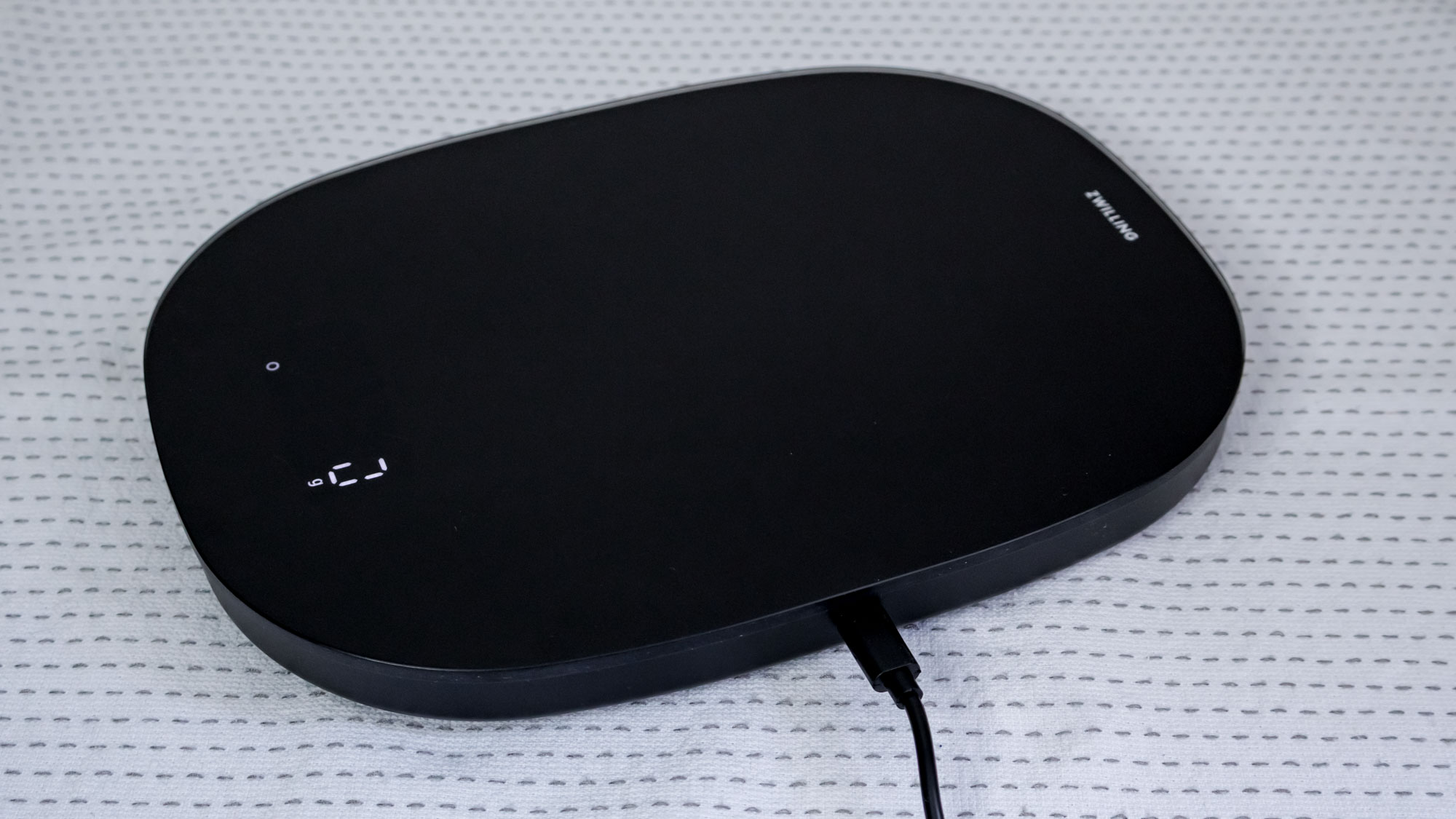
Specifications
Reasons to buy
Reasons to avoid
I have an overwhelming need to stroke this kitchen scale. It’s particularly sleek, slimline, and smooth and is incredibly compact if you’re short on space. But don’t let its basic look deceive you; it’s an exceptional scale, and I might be sneaking this one into my kitchen cupboard rather than returning it to the Tom’s Guide product testing room. Don’t tell!
The scale is incredibly flat, takes on a rectangular form with curved corners, and is lightweight at just 1.76 lbs. It does have a super reflective finish, which is prone to sticky finger marks, but a quick wipe with a damp microfiber cloth will sort it.
Rather than having to insert batteries, which can be difficult to find when needed, this Zwilling kitchen scale is powered via a USB port, conveniently positioned on its side. What’s more, I didn’t need to charge it before its first use — it was ready to go.
Everything is kept to a minimum, and the on/off touchpad button, located on the front edge, also serves as the tare function. But, if you want to swap the measurements from metric to imperial, you’ll find the tab on the underside — although this isn’t ideal if you’re mid-measure.
Just like its fuss-free design, the scale is easy to use and even has a sneaky function that allows you to press the tare button again after adding a second ingredient to see the combined weight. The display is also clear despite the highly reflective surface. However, you may need to be careful about the size of the bowl you add on top, as it could obstruct your view.
If you are looking for precise accuracy for measuring yeast or coffee beans, I would recommend KitchenAid's dual scale.
- Read my Zwilling Kitchen Scale review
Best budget kitchen scale


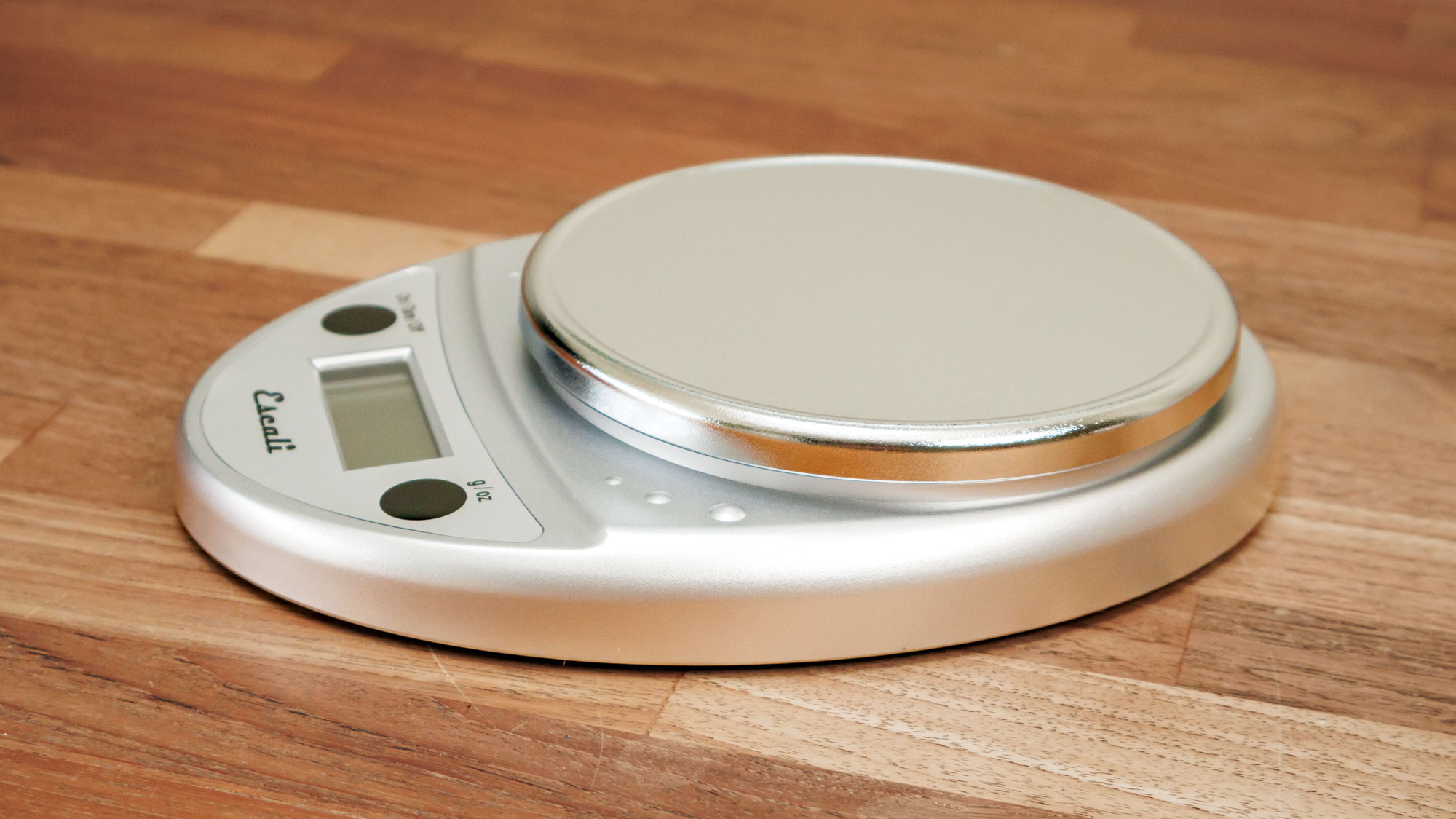
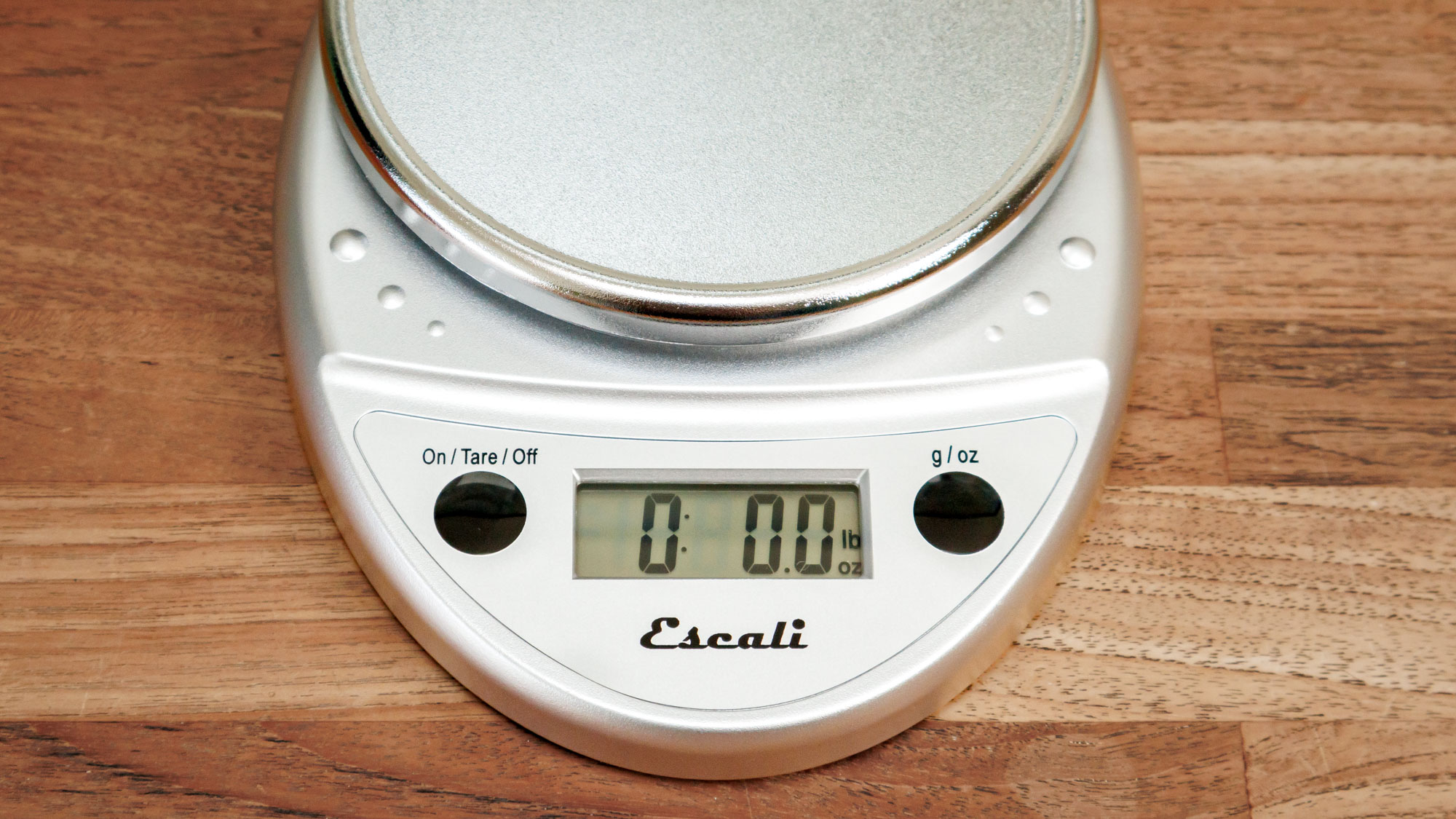
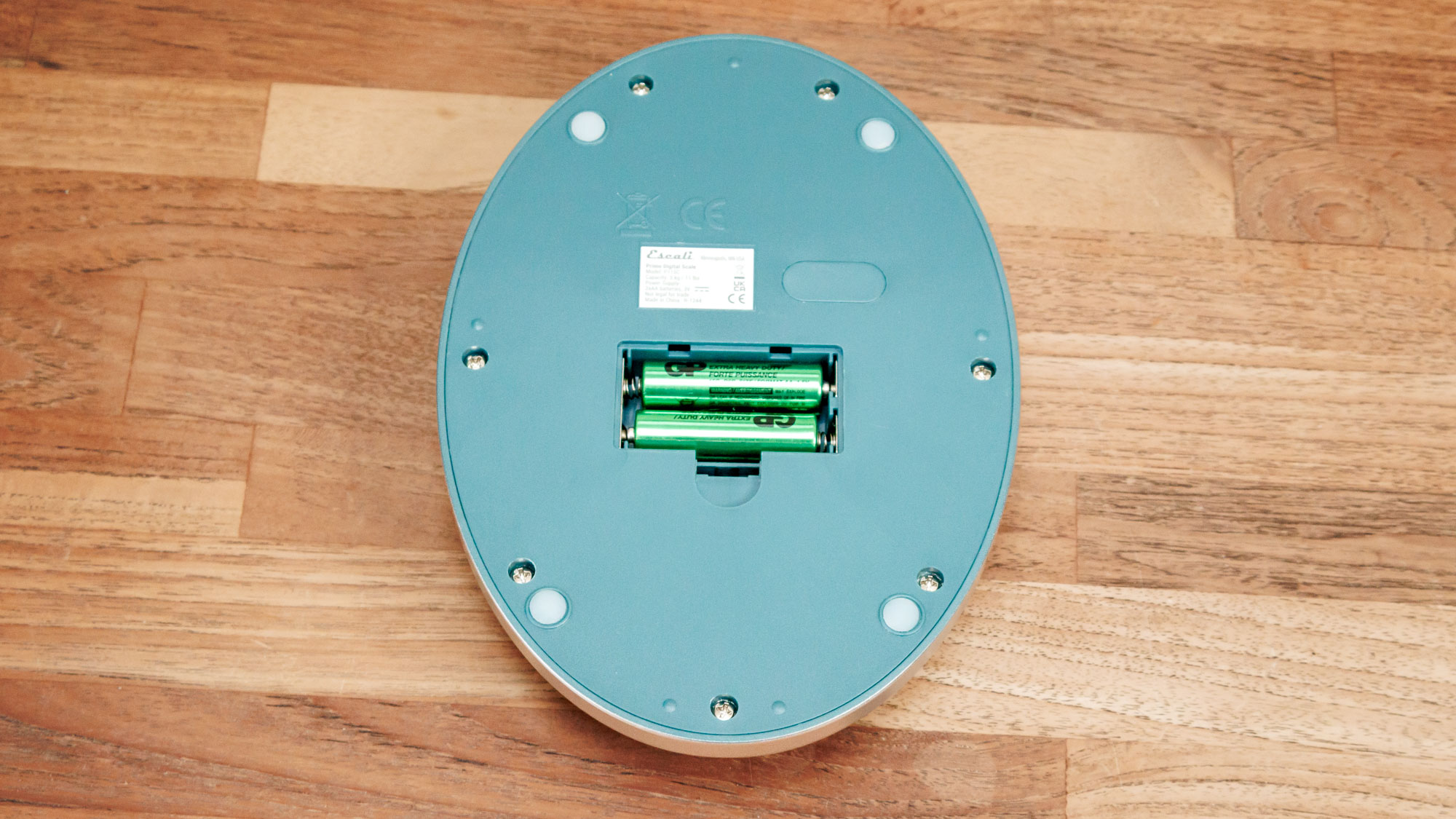
Specifications
Reasons to buy
Reasons to avoid
I have to tell you a secret. I’ve been using a budget kitchen scale for years, and it’s seen me through a ton of ingredients without any issues. Sometimes, simple is best. It’s one reason why I love Escali’s Primo Digital Kitchen Scale. It looks fairly basic, and it doesn’t have a cutting-edge design, but it works. And if you do want to ramp it up, you can choose something other than Chrome — how about Lavender, Pumpkin Orange, Tarragon Green, or Warm Red?
It came out on top in terms of accuracy and registered a 1g weight, whereas many of the other kitchen scales failed. Have I convinced you? Unlike some other kitchen scales included in this guide, Escali concentrates on manufacturing kitchen scales, thermometers, and timers, so it certainly knows a thing or two about precision.
However, the main downfall is the size of the weighing platform, finding a bowl that doesn’t obscure the display, and the issue that the platform has a raised lip. I get the feeling that this might knock the accuracy if your bowl overhangs the edge. But, saying this, unless you’re using a bowl from a stand mixer, like I sometimes do, it’s perfectly manageable.
The control buttons are positioned on either side of the display and are sealed to protect them against accidental spills; this also makes the scale easy to clean, as you can give it a quick wipe-over. Another advantage is that the material is not overly shiny and doesn’t attract fingerprints like other highly reflective kitchen scales.
I do think this kitchen scale misses a trick on the design front, but you can’t ignore its accuracy and budget price.
- Read my full Escali Primo Kitchen Scale review
Best kitichen scale with bowl

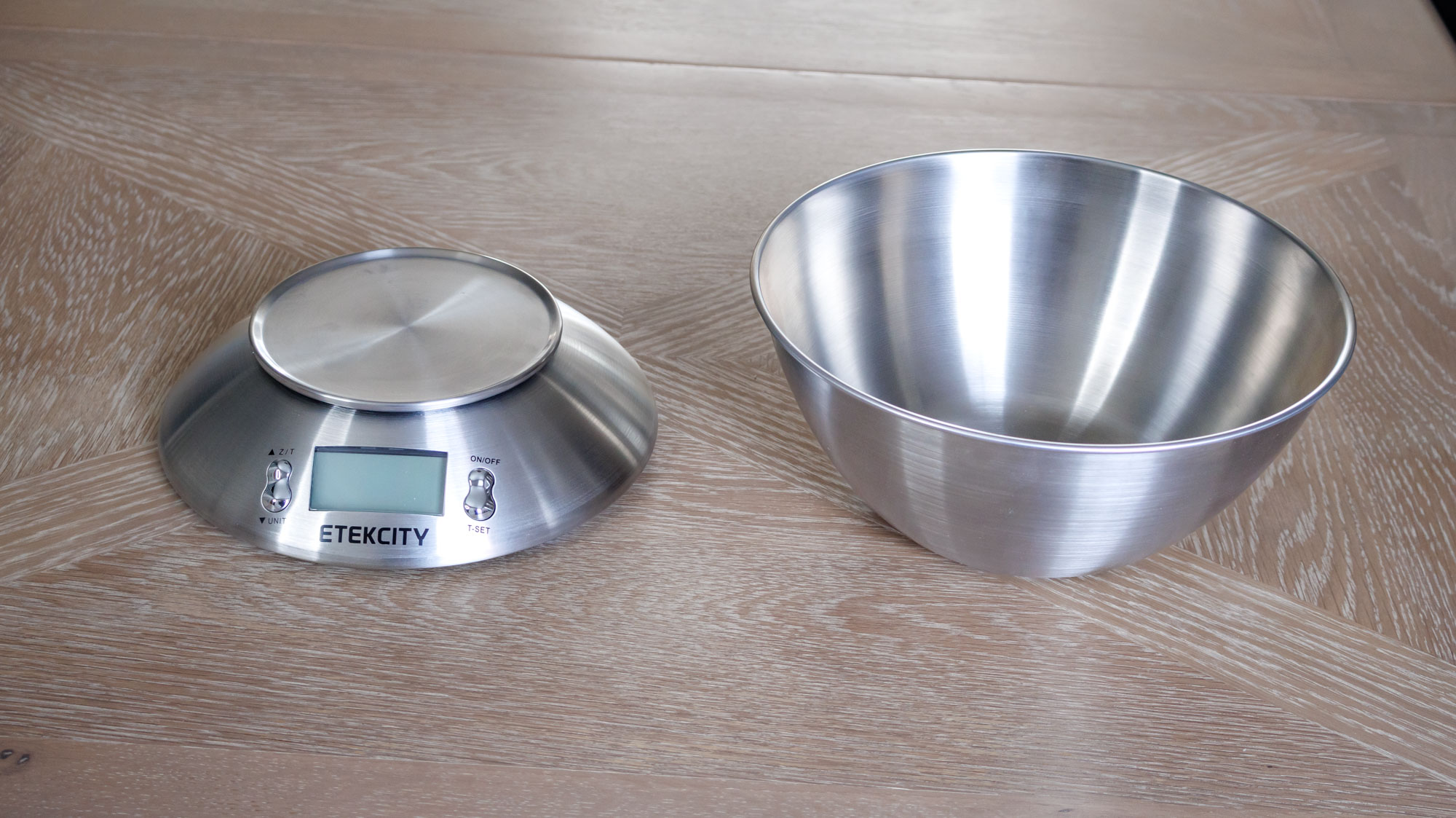

Specifications
Reasons to buy
Reasons to avoid
The Etekcity Digital Kitchen Scale might not look very pretty, but it scores well on accuracy and functionality. For a budget kitchen scale under $20, your money is well spent and saved!
I was impressed with the scale's accuracy when weighing 1g, as other scales in this guide didn't register this small weight. Plus, when using all weights, it measured them without fluctuating by a gram or two before settling on the final measurement.
The bowl is another great advantage, as it is so big and deep, meaning everything stays inside. I work quickly in the kitchen and can be a bit clumsy, but the high-sided bowl keeps the ingredients where they should be, rather than sprinkled about my countertop. The control buttons aren't as simple to use as some kitchen scales, as there's a timer to negotiate too, but if you check the instructions, you'll soon know how everything works. The LED display is clear to read and covers imperial and metric measurements, and as an extra, you'll also be able to see the current temperature. It is a plus if you are making bread and intend to prove dough.
Although this scale is shiny, it is easy to clean, so grab a microfiber cloth if you want to banish fingerprints. Also, it's not as small as some kitchen scales because of the bowl, so consider if storage will be an issue before you buy.
Overall, it makes a great budget kitchen scale for the price.
Best dual kitchen scale

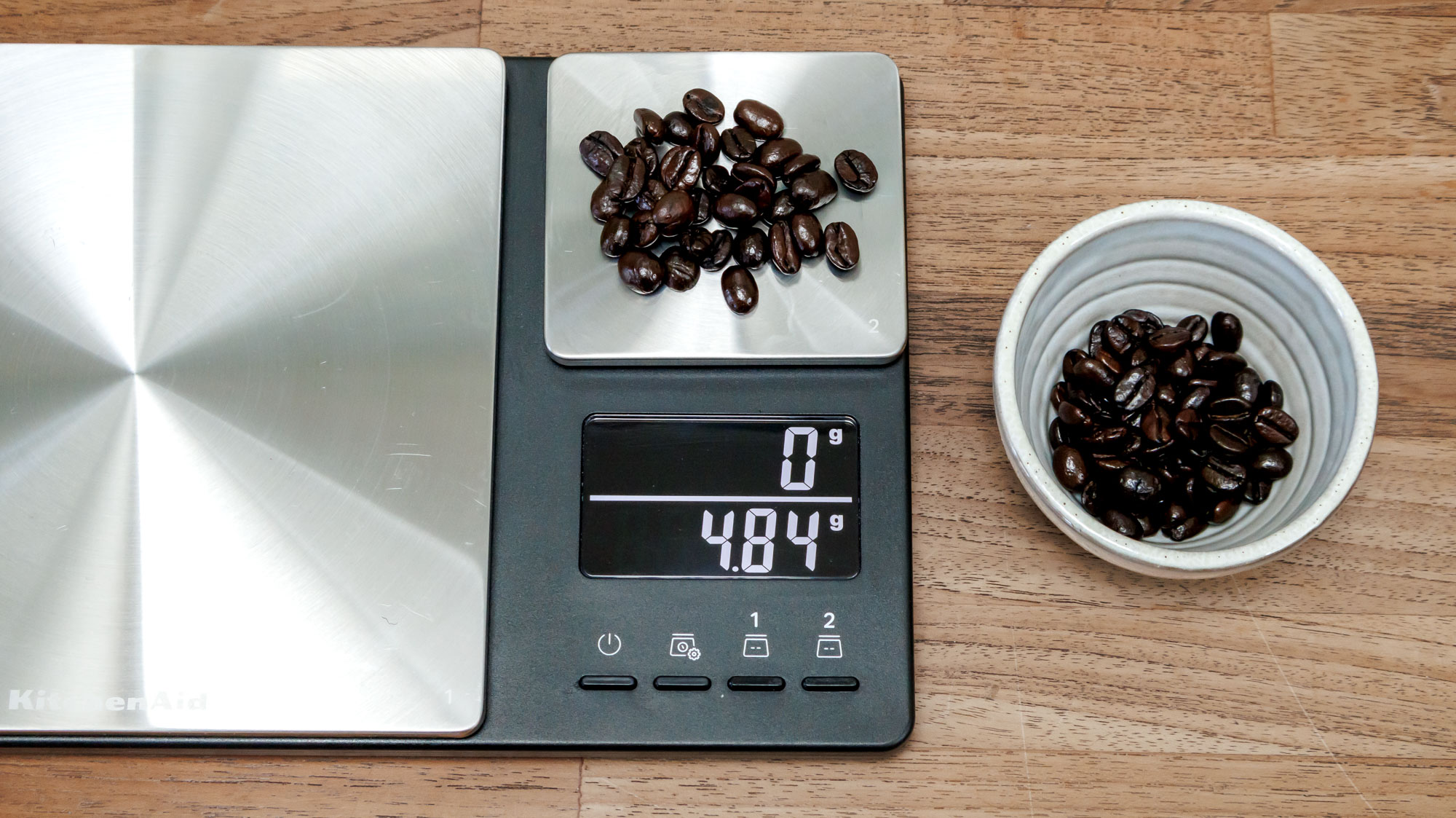
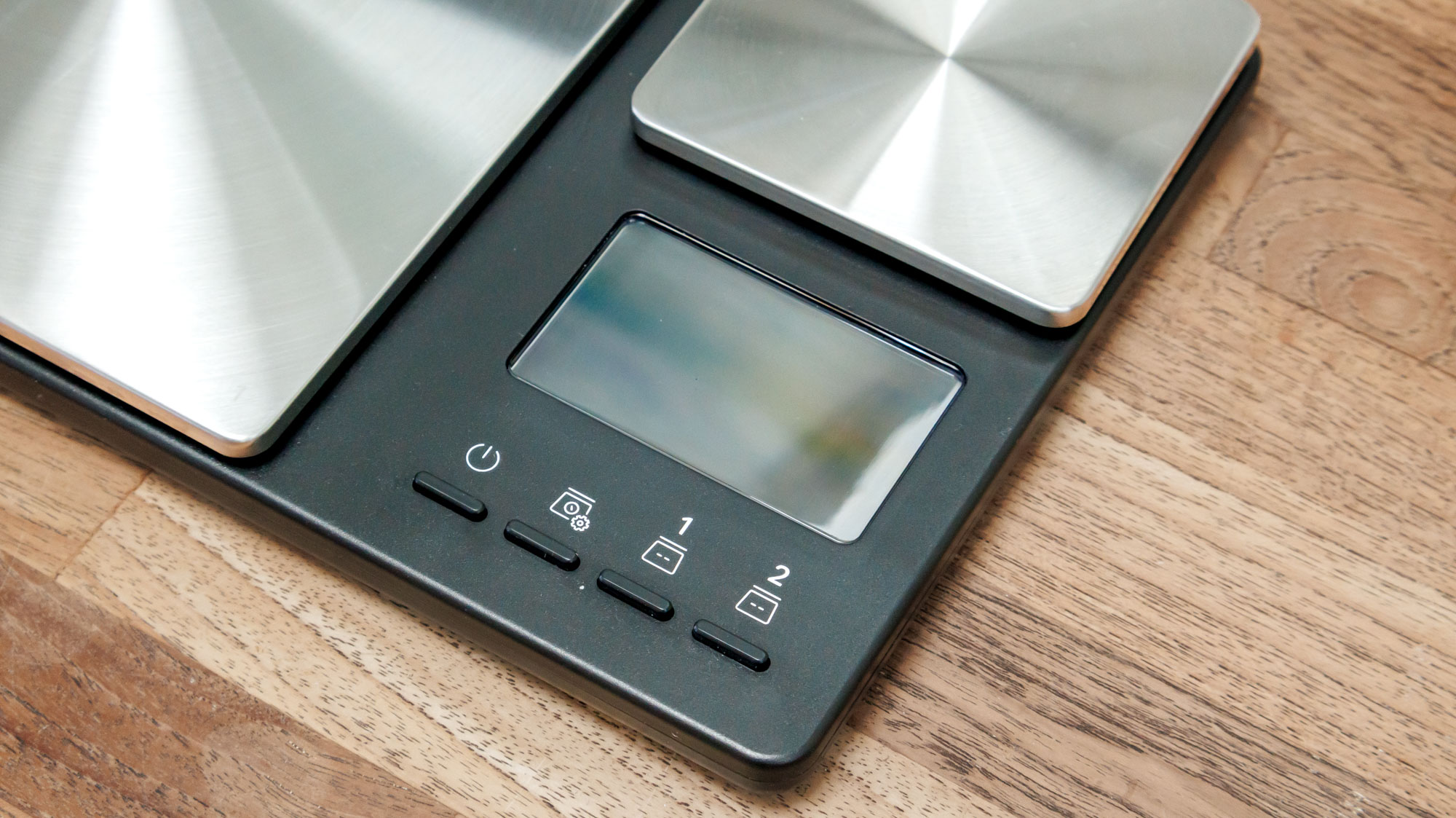
Specifications
Reasons to buy
Reasons to avoid
My first impression when I saw the KitchenAid dual scale was how much I liked the design. It's fairly simple, but with that comes a compact, sleek-looking scale — a must-have for many small kitchen owners when storage is at a premium.
Another advantage is its dual scale, which wins me over because I love multi-functional appliances. My son was also impressed, but from another perspective, he's a coffee aficionado who loves grinding his own beans. Finally, he could use an incredibly accurate scale to boost his coffee-making prowess.
One thing you don’t get with this scale is a bowl, but I never see this as a problem, you just have to remember to reset the tare button if you place your own bowl on the scale. What’s more, the scale is intuitive to use, and it won’t take you long to work out how to switch the measurements from imperial to metric and vice versa. In fact, the hardest part is removing the battery cover on the reverse of the scale, which you hopefully won’t have to do too often!
The smaller scale measures up to 16oz (500g) and gives a reading with three decimal places for ounces and two decimal places for grams. When I weighed a small amount of coffee beans it measured 0.170oz/4.84g. The larger scale measures up to 11 lbs (5kg). I also found the scales to be very accurate, with the larger scale picking up a 1g calibrated weight where other scales I have tested failed.
I also found the LED clear and easy to read, despite my limited photography skills portraying otherwise!
- Read my full KitchenAid Dual Platform Digital Scale review
Best kitchen scales for large loads
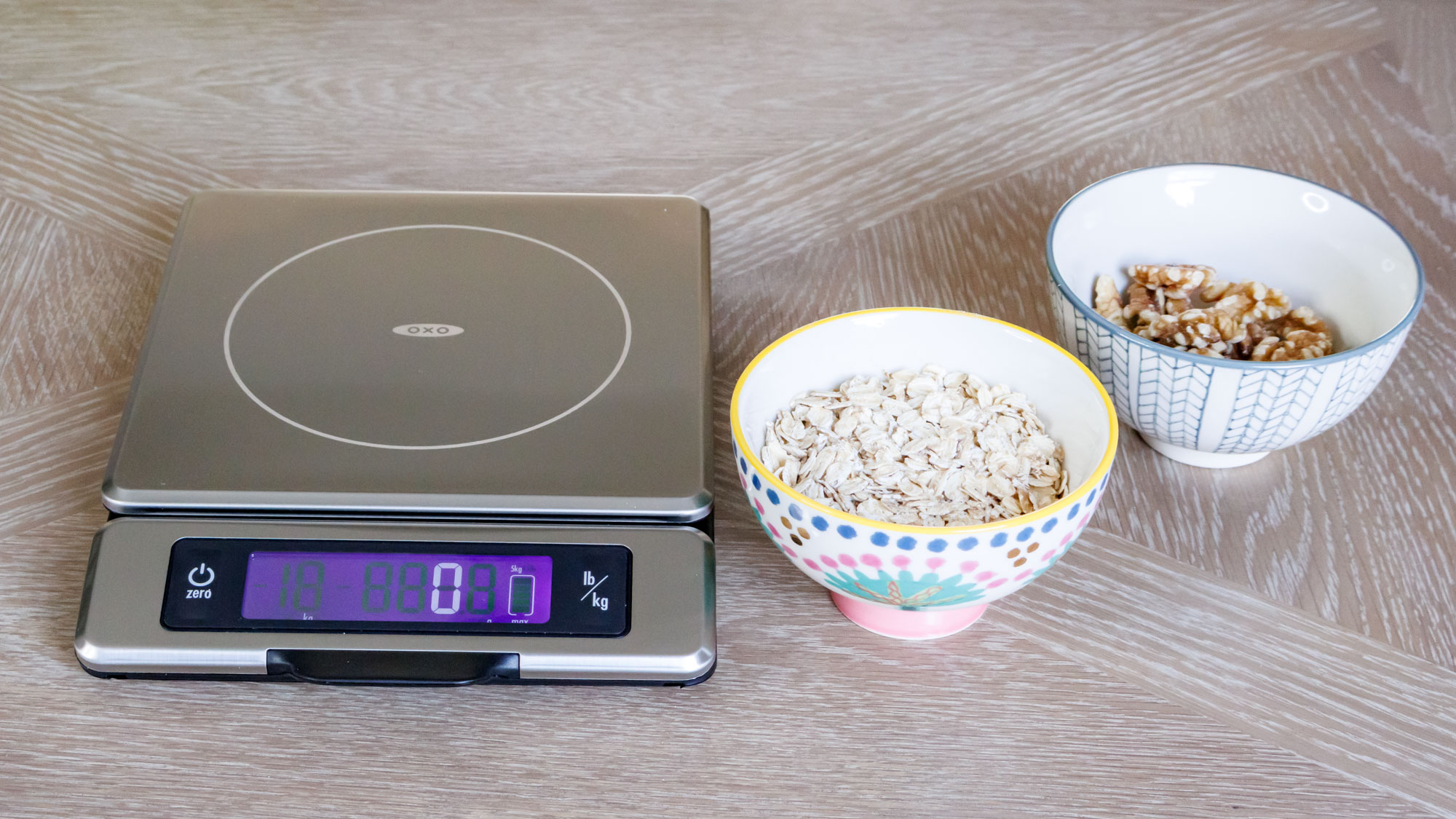
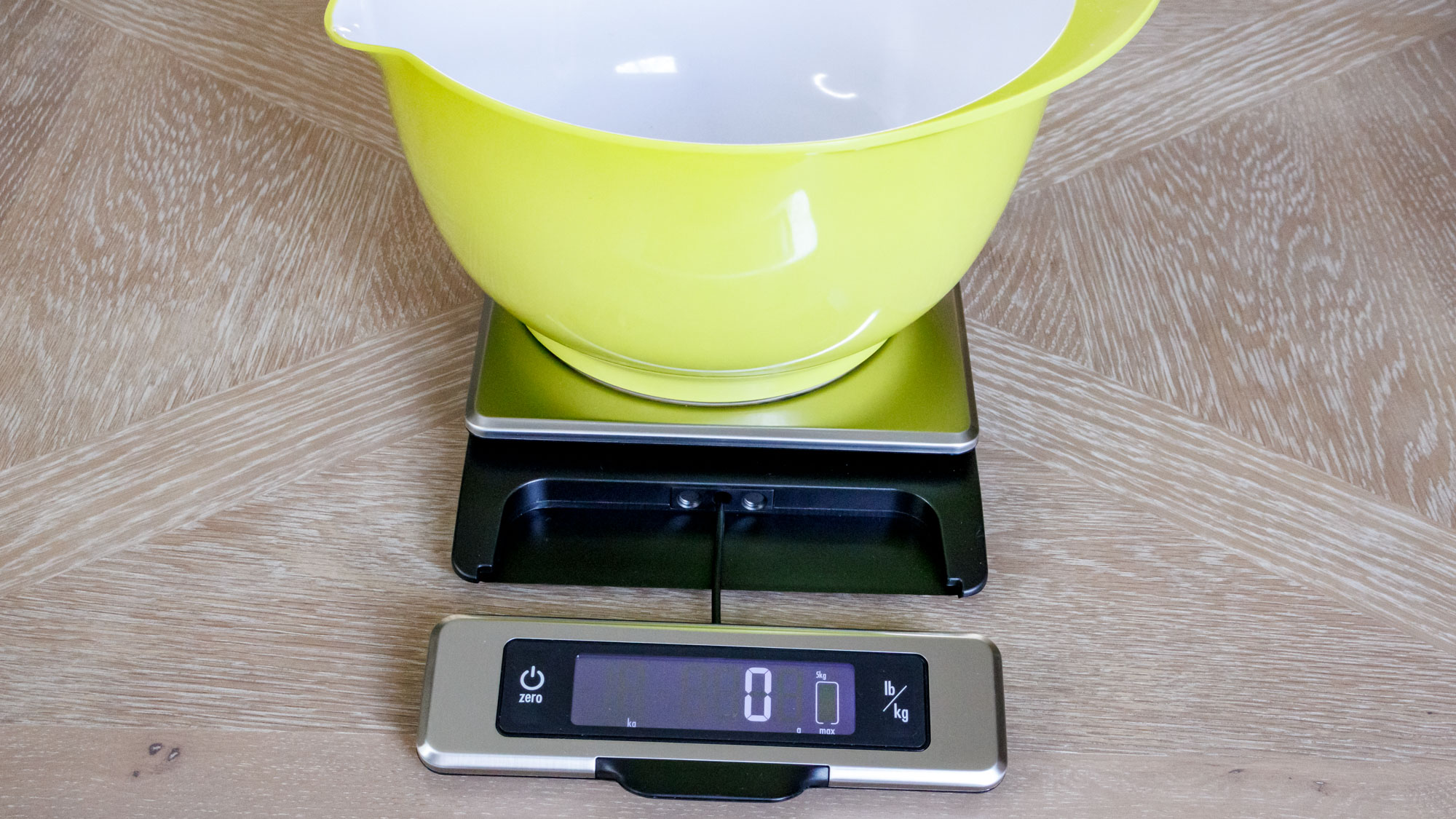
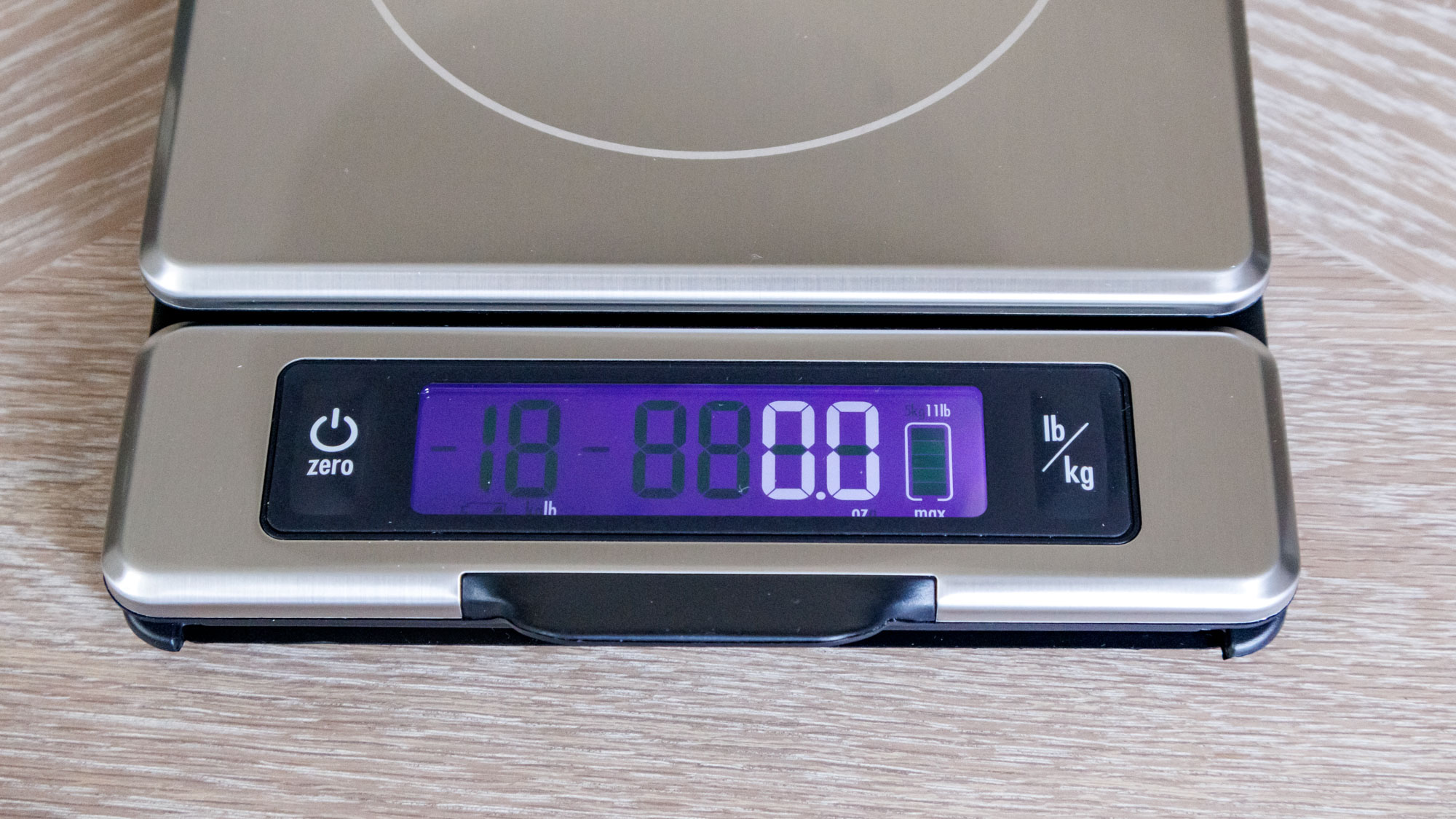
Specifications
Reasons to buy
Reasons to avoid
I wasn’t wowed over with the design of the OXO Good Grips food scale, although, overall, it offers a sleek and compact design. However, I was impressed with its functionality and the benefit of having a pull-out display. And, although they are on the pricier end of the kitchen scales I reviewed, at around $55, this feature alone could win you over.
The pull-out display allows you to place large pots or bowls onto the platform without the measurement being obscured — a big win if you tend to batch cook and weigh large quantities.
The scale was slightly off with the accuracy test, but only by 1g or 2g, but if you’re not looking for a precision scale to weigh fine amounts of yeast or small quantities of coffee beans, this shouldn’t put you off.
The scale was easy to use, and the buttons soft to press, with the reading appearing quickly. Changing between grams and ounces was also fast, along with resetting the scale using the tare function.
What’s more, unlike some scales that go into standby mode after about two minutes, these stayed fully functioning for five minutes before they dulled out, and they didn’t turn off completely for another 10 minutes. If you’re a distracted cook, and often get called elsewhere, this is a useful feature that will get you back on track without having to reweigh your ingredients.
Any scale featuring stainless steel will be a bit of a pain to clean, as the shiny metal will show sticky fingerprints and watermarks, and this design is no exception. However, there could be a potential cleaning issue getting between the base of the scale and the weighing platform. But, fear not! OXO has designed the platform to be removable, meaning that you can give the metal platform a hygienic clean, while also getting underneath and wiping over the plastic base.
- Read my full OXO Good Grips 11 lb Food Scale review
Best smart kitchen scales

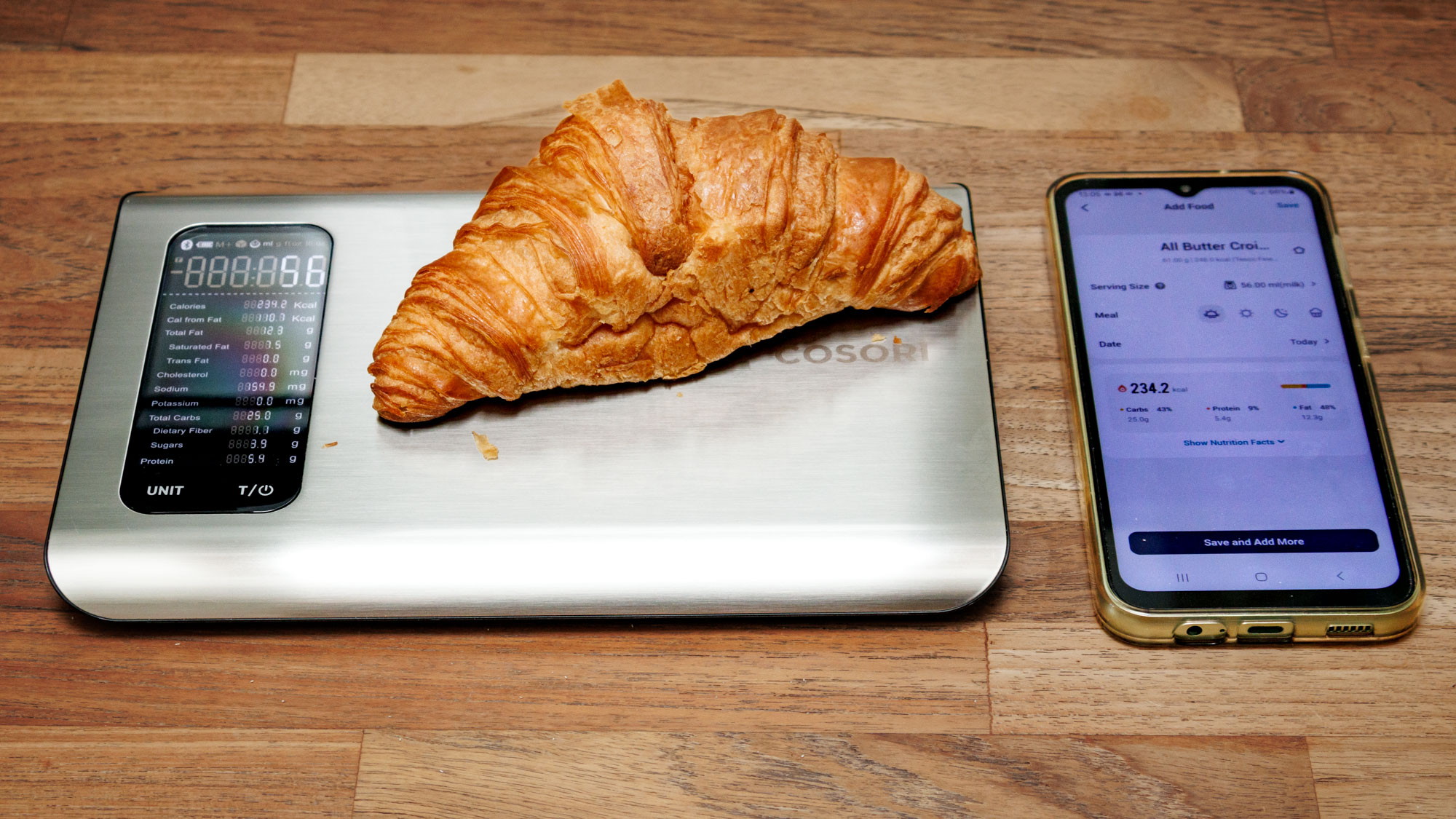
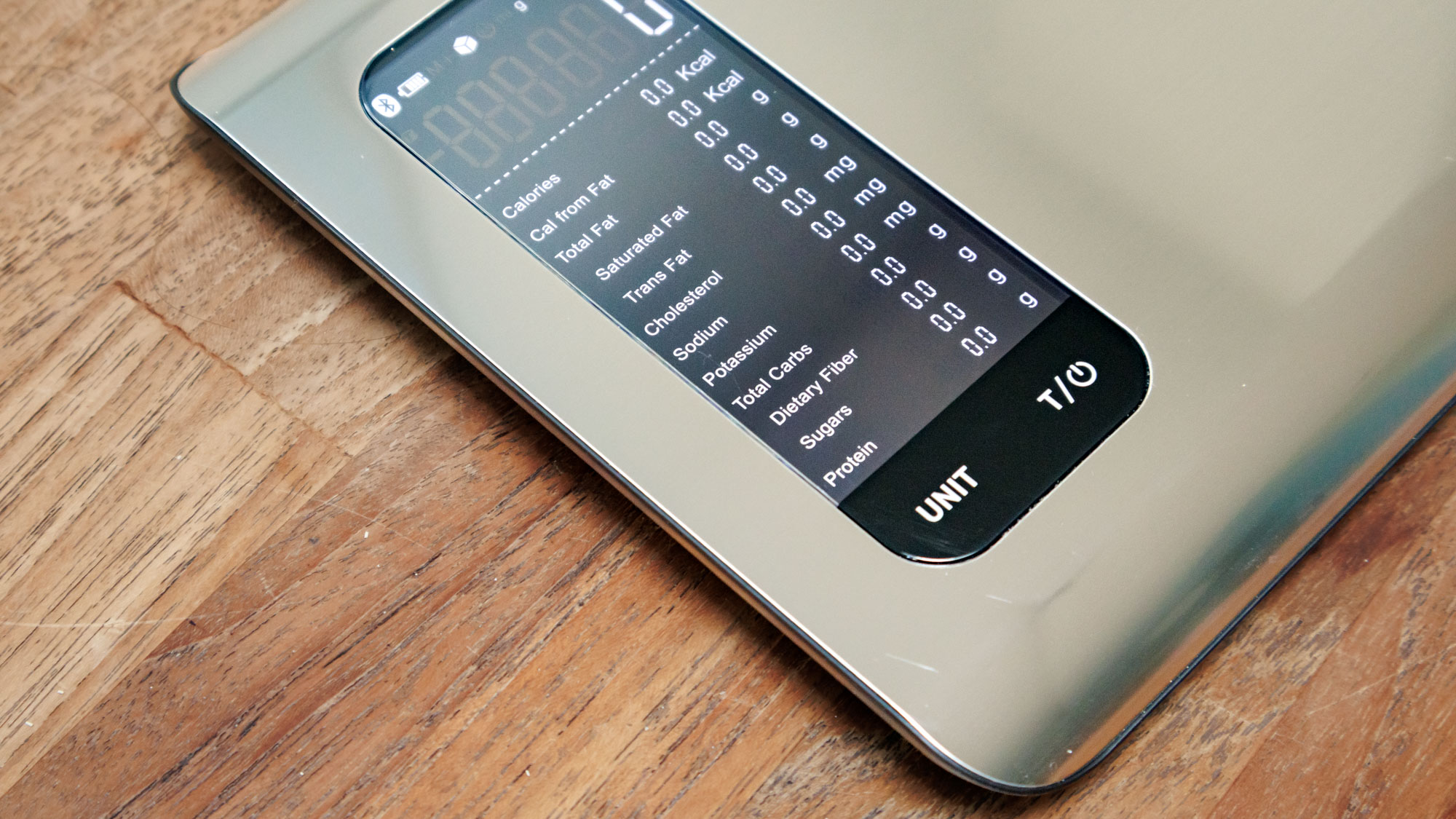
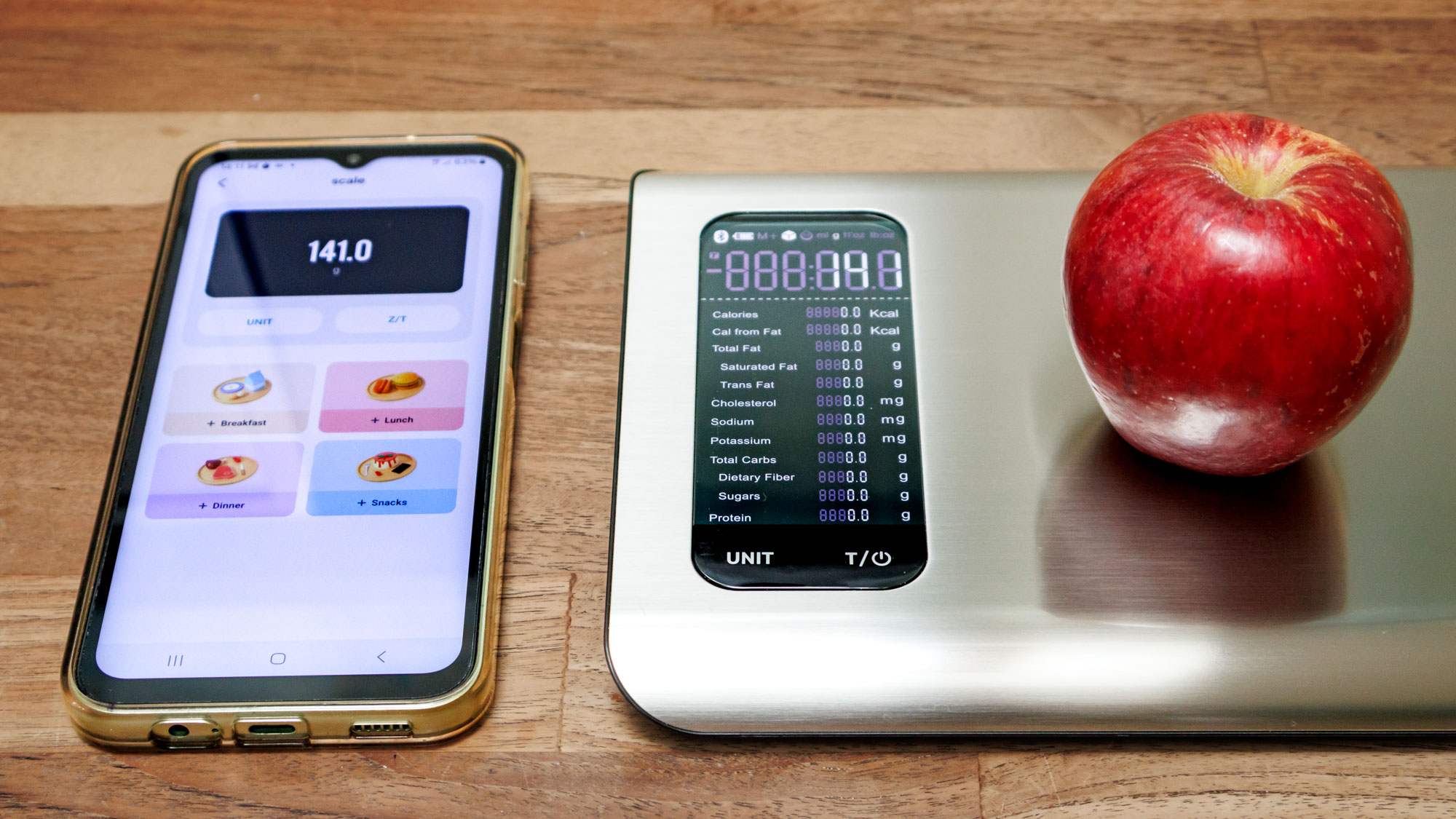
Specifications
Reasons to buy
Reasons to avoid
I must admit to being a little bit scared when I first tested the Cosori Smart Nutrition Scale. I’m used to using a range of kitchen scales to weigh ingredients for recipes, rather than to track the food’s nutritional content. However, I like the idea that apart from monitoring calories, you can also see the nutritional breakdown of what you weigh; this is much more insightful and a big bonus for those following a training program or a specific diet where you need to keep certain elements to a minimum or boost others.
The only thing you’ll need to do is download the free VeSync app, which enables you to view the fine details. I’ve been accustomed to following this procedure when using numerous meat thermometers, including Cosori’s Smart Thermometer, and it’s extremely easy, even for someone who doesn’t crave technology. However, the only downside is that it doesn’t come with a great deal of instructions, but don’t let this dissuade you.
I really liked the design of this smart scale. It’s extra sleek with a large display (which is needed to display all the nutritional details), and it’s a winner when it comes to cleaning. Simply wipe over with a damp cloth, and you’re done. There’s no chance of food residue getting stuck in any crevices.
When it comes to accuracy, and I’m talking small amounts, this scale is not the best, so I wouldn’t rely on it for measuring 5g of dried yeast. But, I’m missing the point because this scale is a nutritional scale and not designed for bakers.
Best kitchen scale for bakers
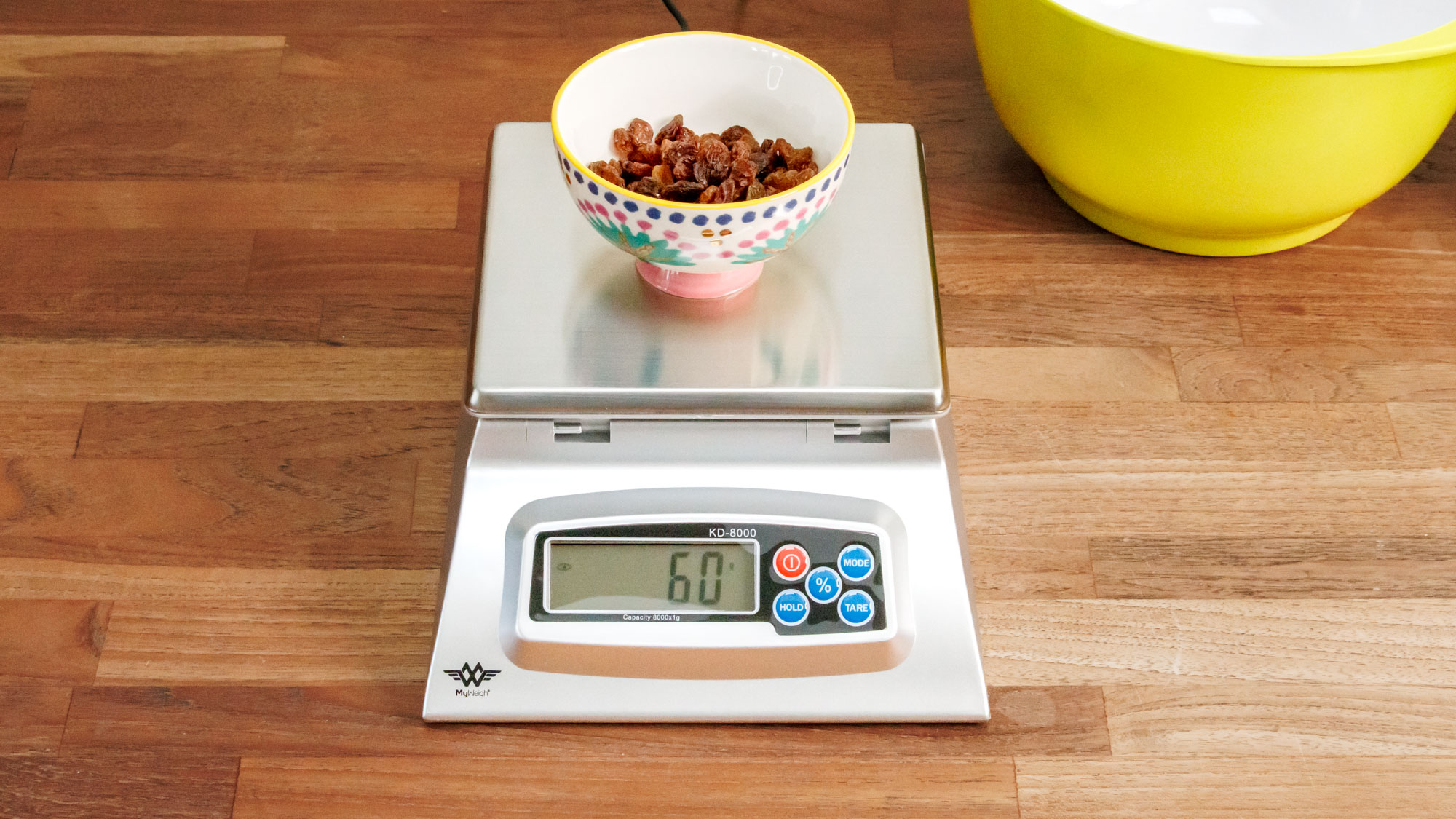
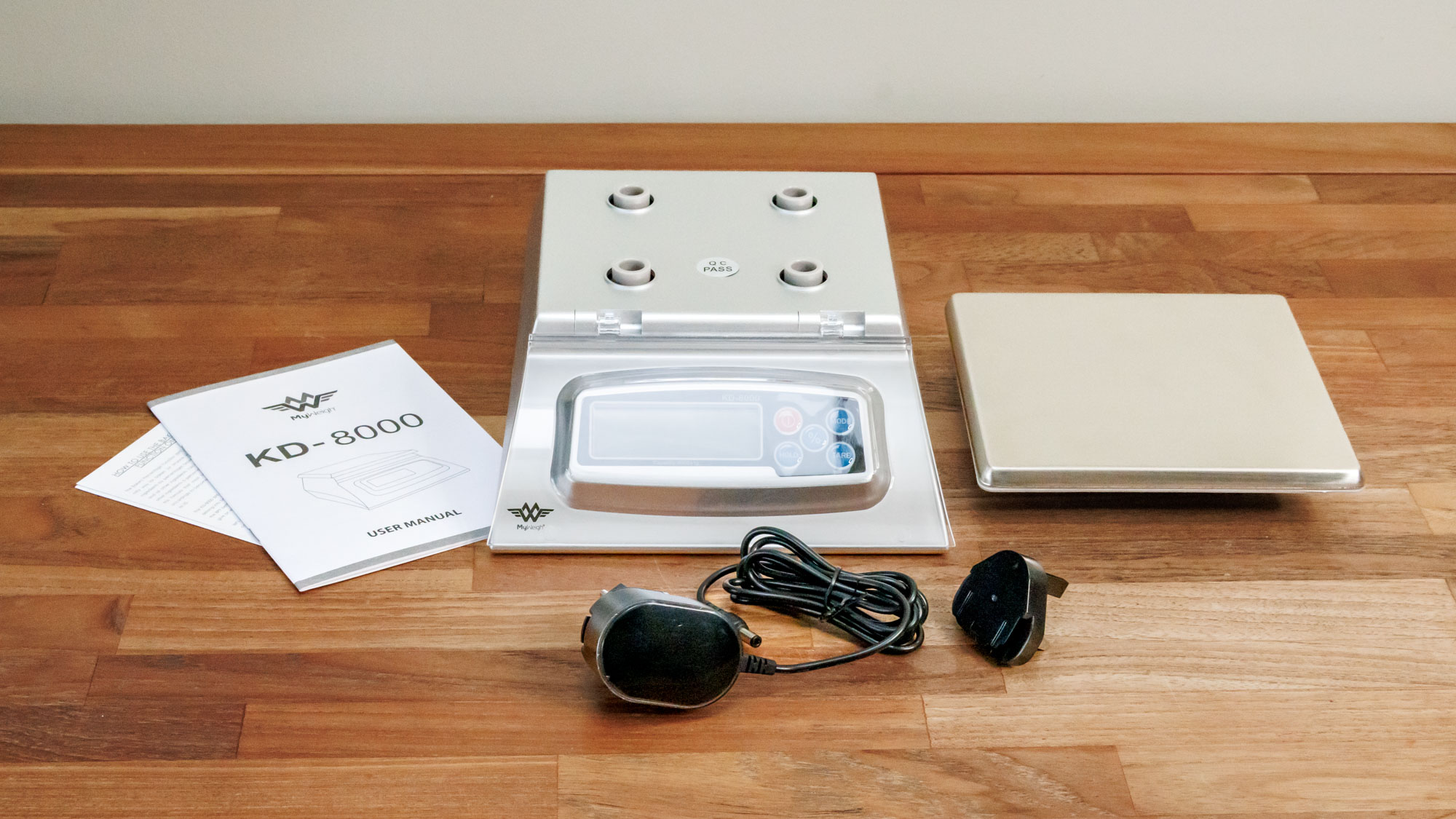
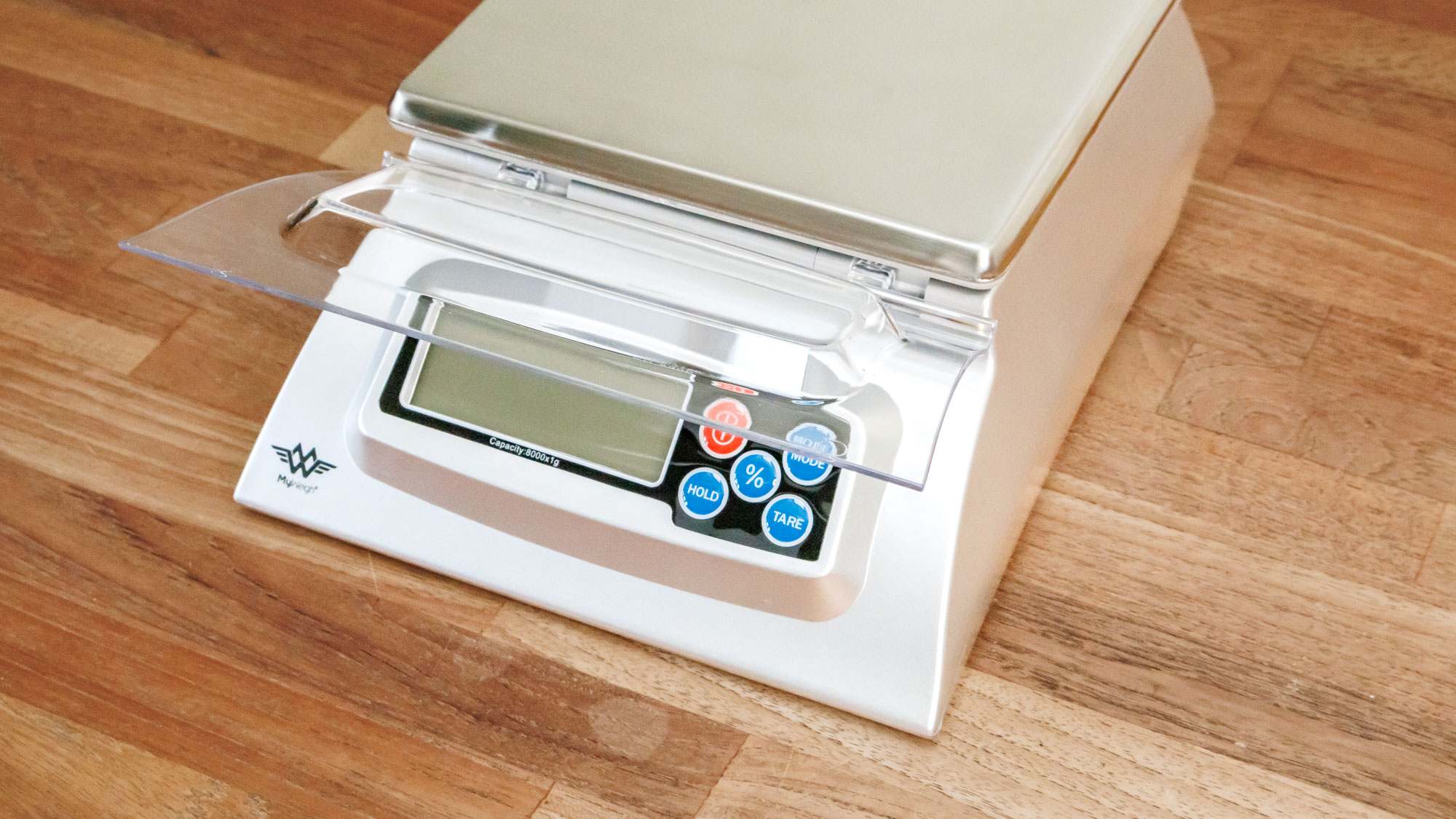
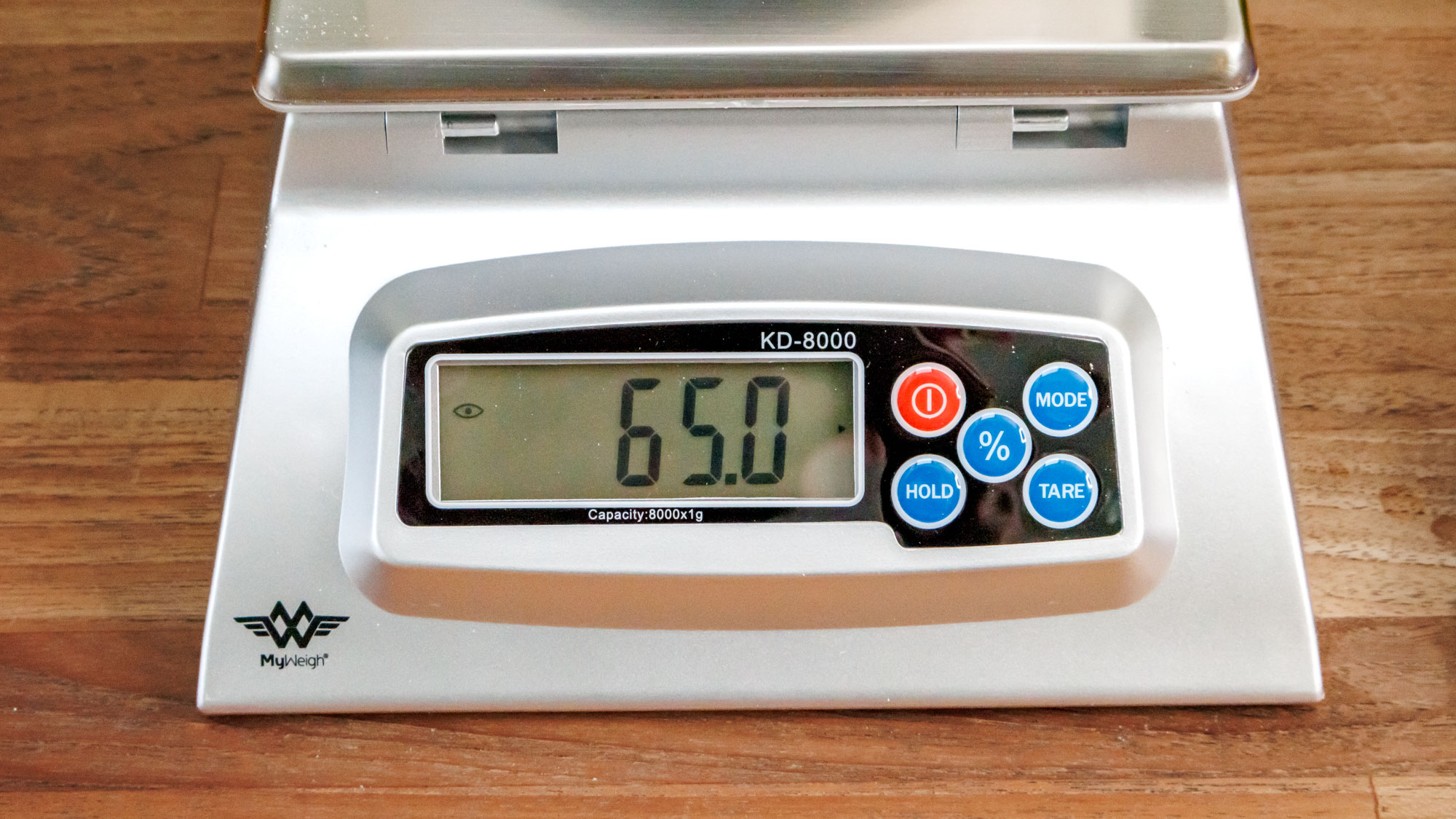
Specifications
Reasons to buy
Reasons to avoid
If I were choosing a kitchen scale for looks alone, I wouldn’t add the My Weigh scale to my shopping basket. But here, I’m ignoring my own advice — don’t let looks deceive you. Although it’s a bit of a monster, it really means business.
Apart from weighing close to 18 lbs, it’s incredibly baker-friendly, which is why I recommend it as the best scale for bakers. Unlike any of the other kitchen scales I’ve tested, it has a Baker’s Percentage function. This feature enables breadmakers to scale a recipe up or down according to fixed ratios. It’s not for everyone, but it’s a handy function if you’ve got a home bakery going on at home.
The scale did find it tricky to pick up the first gram or two, but it proved to be reliable, registering weights quickly and without any fluctuation. It also features a clear LED display, positioned at an angle for easy visibility. You’ll also find it has a cover that protects the display. The idea is to shield the display from flour and other ingredients, but while the display is covered, you can’t access the buttons. For instance, you’ll need to lift the cover to press the tare function. I found it a bit of a nuisance, but this is easily remedied, as you can lift and slide the shield across to remove it.
I’m not a fan of plug-in kitchen scales, as when I’m baking, I already have enough clutter on my countertop, but with the My Weigh you get the option to plug in a cable or insert batteries. It’s good to have this dual option.
Also tested
Not all of the kitchen scales I test meet the requirements to gain a place among my top recommendations. However, they still have worthy attributes, which might be what you are looking for in a kitchen scale.
SMEG Contemporary Kitchen Scales (★★★★☆)
This kitchen scale is majestic and will stand out on a countertop, but I found the internal bowl was difficult to remove and I didn't feel it warranted the high price point.
However, SMEG enthusiasts will love it, and the scale performed well on the accuracy test. Plus, it's charged with a USB cable, so if you can never find any batteries and you're looking for an aesthetic kitchen scale, this one could tick the box.
Read my full SMEG Contemporary Kitchen Scale review
Joseph Joseph SwitchScale (★★★½★)
This is a neat scale with a bowl that can flip over for compact storage, but I found there is a flaw in the design. When the bowl is in use you'll have to step back and view the display. I also found that the bowl is small with shallow sides, which can cause a flurry of flour, and isn't ideal if you tend to way large amounts of ingredients.
That said, SwitchScale does give you the option to use the scale without the bowl.
Read my full Joseph Joseph SwitchScale review
Expert buying advice
Meet our experts
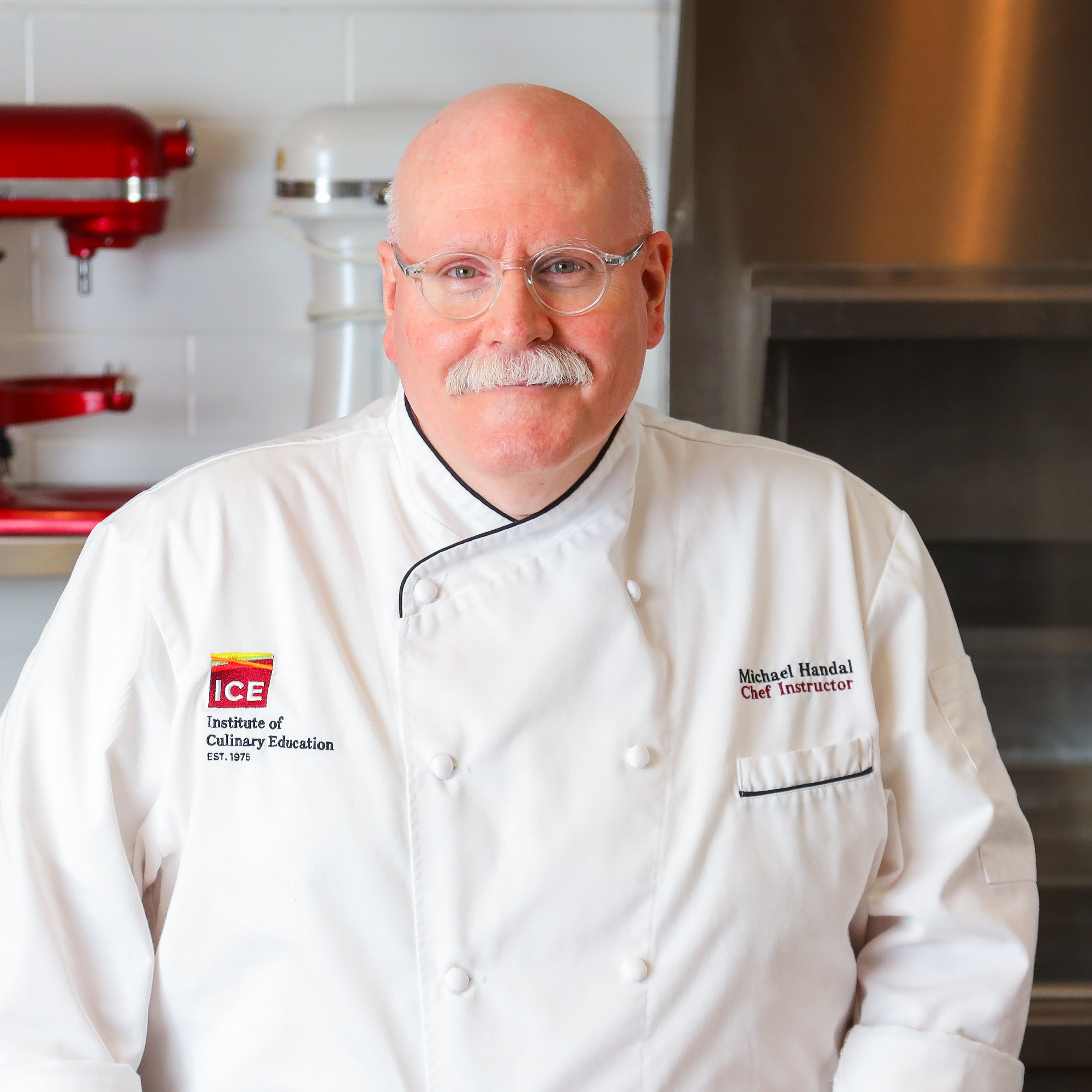
My training and experience has been grounded in classical French cuisine, from pastry to butchering, from purchasing and receiving, from garde manger to running a kitchen brigade, everything I have done in my career has pointed me towards teaching others how to cook professionally.

I'm the head chef, recipe creator, writer and photographer behind The Forked Spoon, where you'll find family-friendly recipes for the everyday cook. For over 14 years, I've been crafting and sharing more than 1200 recipes, blending flavors with practical kitchen tips and expert culinary advice.
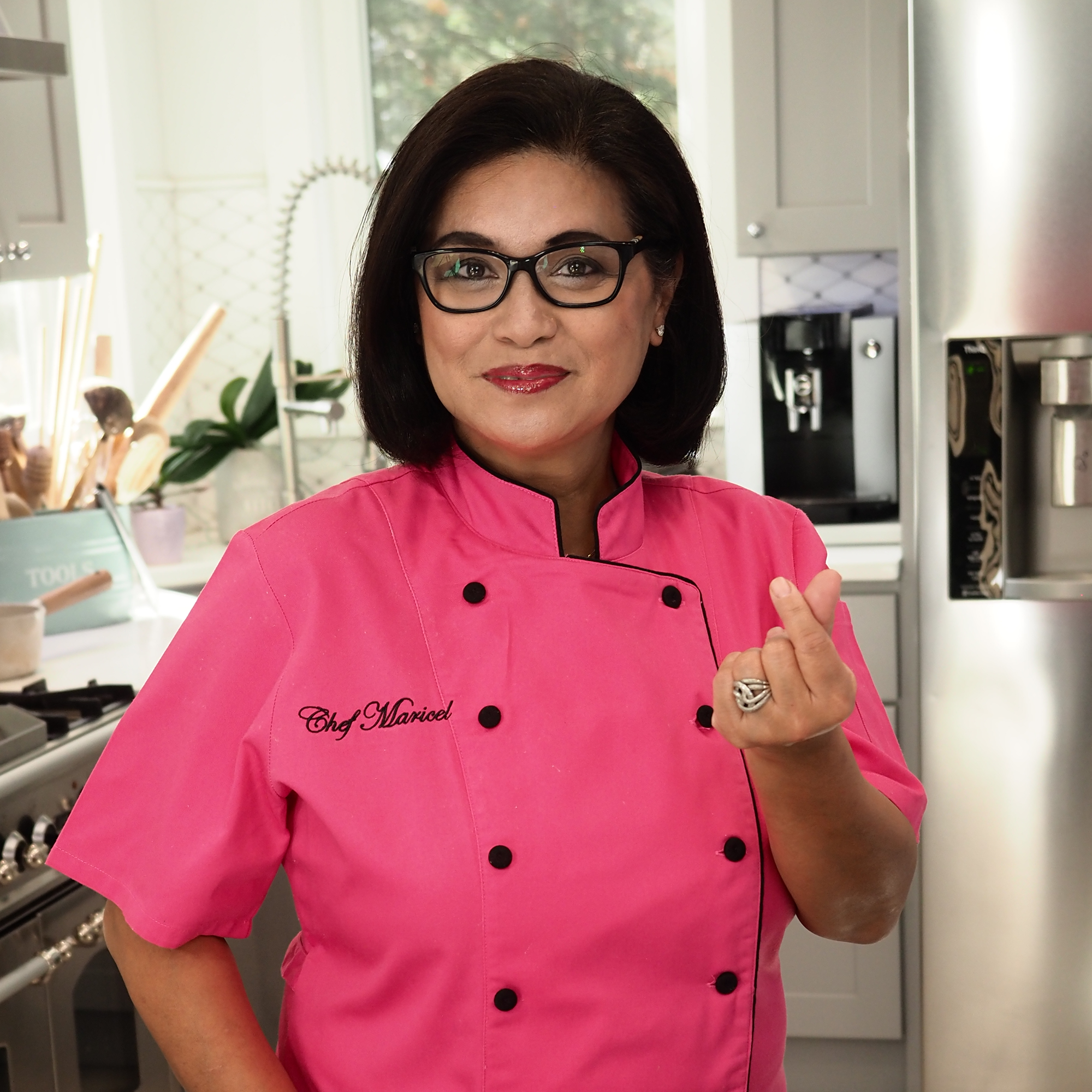
I started Maricel’s Kitchen in 2017 to help others cook Asian food with confidence and joy. My love for bold, fresh ingredients began in my Lola’s kitchen in Manila. Since then, I’ve shared that passion on Hulu, PBS, and Food Network — and now through my cookbook, Maricel’s Simply Asian Cookbook, filled with approachable recipes for every home cook.
Features to look for when buying kitchen scales
Accuracy
There’s no point in using a scale if it’s not accurate, so be sure to invest in a kitchen scale that’s reliable and gives precise readings.
Measurements
Although you probably prefer working in either metric or imperial measurements, your favorite recipes will undoubtedly combine both. As Jessica says, “I don’t want to do manual conversions if a recipe is in either.”
For this reason, your scale of choice should have a selection of measurements and be easy to switch between options.
Tare function
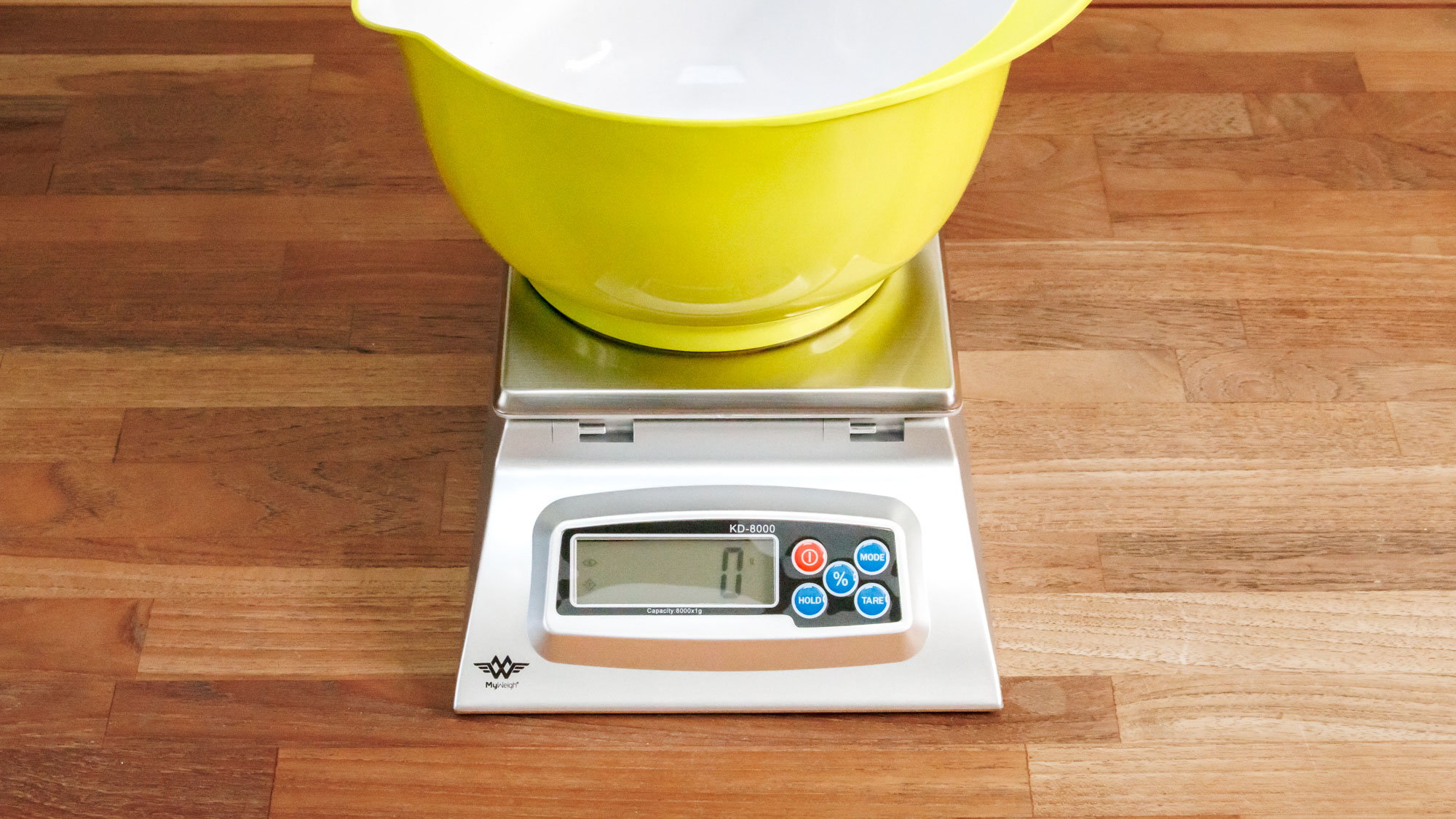
A tare function is an essential feature. It allows you to zero out a container’s weight during a recipe, but it can also be used to reset the scale if you are measuring more than one item into your bowl at a time.
Capacity
Apart from a scale that can measure a decent amount of weight, Michael says to look for one that can accommodate the size of bowl you usually use in your recipe preparation. But do remember to press the tare button before adding your ingredients.
He also advises that your scale should handle the maximum weight needed for recipes while being able to measure the smallest weight too, “whether that is a portion of an ounce or micrograms.”
Display
Look for a clear and easy-to-see display, with a good clearance from the bowl, with Michael suggesting, “A pull-out display option is helpful for use with larger bowls or containers.”
Jessica also advises to choose a scale with a digital readout for accuracy.
Cleaning

Consider how easy the scale will be to clean. Are there lots of nooks and crannies that ingredients can get caught under, or will it be easy to wipe clean?
Auto-Off
An auto-off function will save on battery life, and will stop you having to think about turning it off when you’re busy in the kitchen.
How to care and maintain your kitchen scales
It’s worth taking care of your kitchen scales to keep them in good working order. Jessica recommends always keeping them in a dry place and avoiding exposure to heat, as extreme temperatures can affect their accuracy. And when storing your scales, Maricel recommends keeping them flat, with nothing on the weighing platform. With this in mind, Michael warns against overloading the scale and not exceeding the scales maximum weighing capacity.
Maricel has a handy trick when using her scales to avoid too much mess accumulating on them, “I cover my scale platform with saran wrap or parchment paper— it makes cleanup easy, and ensures that you are working on a sanitary surface if you are weighing dough or something raw.”
And when it comes to keeping them clean Jessica says, “Clean the scales regularly with a soft damp cloth to remove any food debris or spills. Avoid using harsh chemicals or submerging them in water, as moisture can damage the electronic components.”
How to check the accuracy of your kitchen scales
Jessica advises that you can use objects of a known weight, such as a preweighed calibration weights to test the accuracy of your scales. I used the same set of calibration weights during my testing, and the pack contained a 1g, 2 x 2g, 5g,10g, 20g, 50g, and 100g weight.
However, if you don’t want to purchase a set of calibration weights Maricel recommends using something from your kitchen cupboards, but removing the packaging beforehand. She favors using a pound of butter, but says flour can work too. However, you’ll need to check that the bag isn’t ripped and flour has leaked.
Alternatively, Michael suggests using your spare change, advising that new pennies weigh 2.5g and nickels weigh 5g.
If you’re still experiencing accuracy issues, he suggests, “Remove the batteries from the unit, wait a few minutes and then re-install the batteries. Replace the batteries if the issue persists.”
It’s also worth ensuring that the scale is on an even surface. “Some units may have a re-calibration procedure, and these steps should be available in the owner’s manual. Some units may also have a factory re-set function, as well,” Michael adds.
Are dual-scales worth it?
You might wonder whether dual scales are worth it or whether you should have two — one for standard measurements and another for precision weighing.
Michael Handel, says opting for a dual-platform scale may be helpful, but it depends on your needs during recipe preparation. “A regular kitchen scale will be able to weigh ounces and increments of an ounce. A larger platform scale will show conversions of pounds and ounces to whole grams.”
However, he adds, “If you need to weigh ingredients in increments smaller than a gram, say tenths or hundredths of a gram, then a dual-platform scale would be very helpful. You would then have the option to do several types of weight calculations on one unit.”
What is the tare function?
The tare function on scales resets the display weight back to zero. Therefore, if you place a plate or bowl on top of your scales, before adding ingredients, you can reset the weight, so that you start from zero.
You'll also find it helpful if you like to add all of your ingredients into a bowl in one go, for instance when making a cake batter using the all-in-one-method. This will allow you to reset the weight every time you want to add another ingredient.
I’d prefer to opt for a dual-scale, as it’s more space-saving than having two, however, Maricel isn’t a fan of multi-use items and has a large scale for items over a pound and a smaller scale for smaller measurement. It comes down to individual choice and what you are measuring.
Get instant access to breaking news, the hottest reviews, great deals and helpful tips.

Camilla is the Homes Staff Writer and covers everything to do with homes and gardens. She has a wealth of editorial experience, mounting over 30 years, and covers news and features, tests products for reviews and compiles buying guides.
Her work has appeared in business and consumer titles, including Ideal Home, Real Homes, House Beautiful, Homebuilding & Renovation, and Kitchen & Bathroom Business. She’s even appeared on the cover of Your Home, writing about her own house renovation.
Although she’s obsessed with decorating her home, she also enjoys baking and trying out the latest kitchen appliances. But when she’s not inside, you’ll find her pottering about in her yard, tending to her vegetable patch or taking in her prized hydrangeas.
